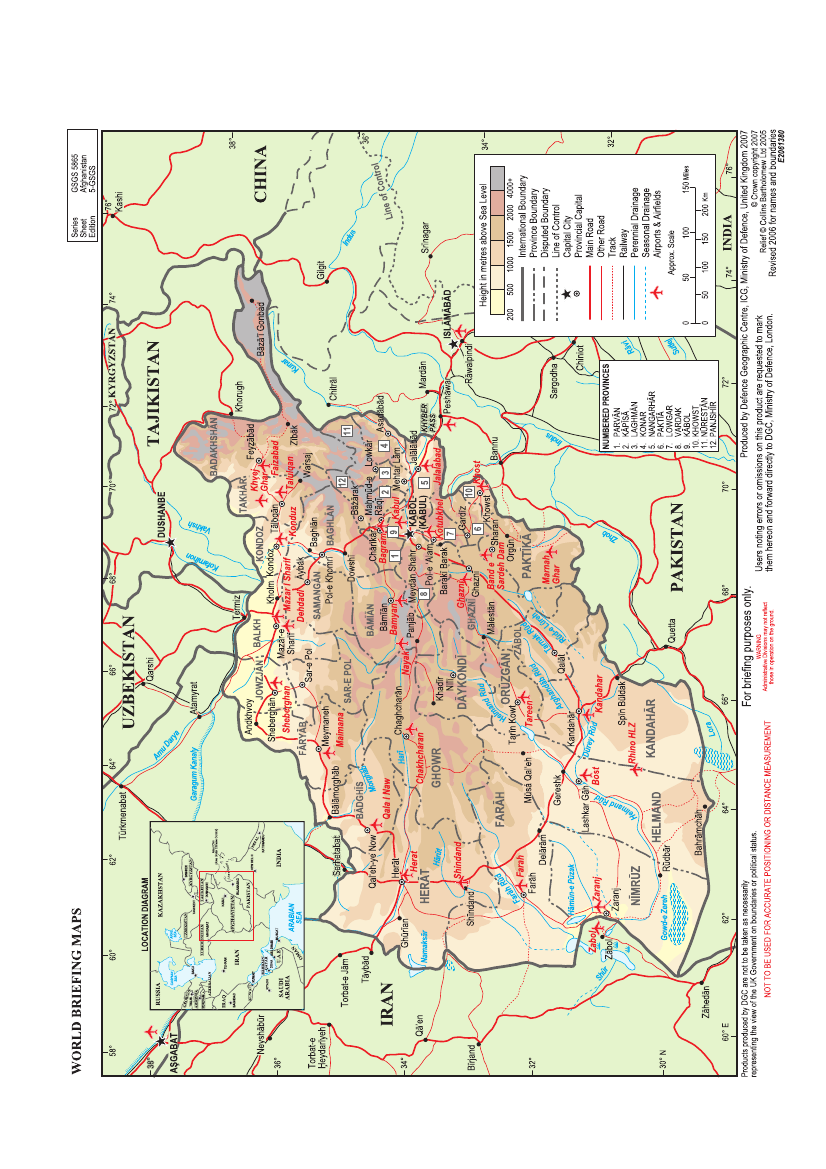Forsvarsudvalget 2007-08 (2. samling), Det Udenrigspolitiske Nævn 2007-08 (2. samling), Udenrigsudvalget 2007-08 (2. samling)
FOU Alm.del Bilag 79, UPN Alm.del Bilag 50, URU Alm.del Bilag 79
Offentligt
House of CommonsInternational DevelopmentCommittee
ReconstructingAfghanistanFourth Report of Session 2007–08Volume IReport, together with formal minutesOrdered by The House of Commonsto be printed 5 February 2008
HC 65-I[Incorporating HC 1097-i, Session 2006-07Published on 14 February 2008by authority of the House of CommonsLondon: The Stationery Office Limited£0.00
International Development CommitteeThe International Development Committee is appointed by the House ofCommons to examine the expenditure, administration, and policy of theDepartment for International Development and its associated public bodies.Current membershipMalcolm Bruce MP (LiberalDemocrat, Gordon)(Chairman)John Battle MP (Labour,Leeds West)Hugh Bayley MP (Labour,City of York)John Bercow MP (Conservative,Buckingham)Richard Burden MP (Labour,Birmingham Northfield)Mr Stephen Crabb MP (Conservative,Preseli Pembrokeshire)James Duddridge MP(Conservative, Rochford and Southend East)Ann McKechin MP (Labour,Glasgow North)Jim Sheridan MP (Labour, Paisleyand Renfrewshire North)Mr Marsha Singh MP (Labour,Bradford West)Sir Robert Smith MP(Liberal Democrat, West Aberdeenshire and Kincardine)
PowersThe Committee is one of the departmental select committees, the powers ofwhich are set out in House of Commons Standing Orders, principally in SO No152. These are available on the Internet via www.parliament.uk.PublicationsThe Reports and evidence of the Committee are published by The StationeryOffice by Order of the House. All publications of the Committee (including pressnotices) are on the Internet at www.parliament.uk/indcomCommittee staffThe staff of the Committee are: Carol Oxborough (Clerk), Matthew Hedges(Second Clerk), Anna Dickson (Committee Specialist), Chlöe Challender(Committee Specialist), Ian Hook (Committee Assistant), Jennifer Steele(Secretary), Alex Paterson (Media Officer) and James Bowman (Senior OfficeClerk).ContactsAll correspondence should be addressed to the Clerk of the InternationalDevelopment Committee, House of Commons, 7 Millbank, London SW1P 3JA.The telephone number for general enquiries is 020 7219 1223; the Committee’semail address is [email protected]FootnotesIn the footnotes for this Report, references to oral evidence are indicated by ‘Q’followed by the question number. References to written evidence are indicatedby the page number as in ‘Ev 12’.
Reconstructing Afghanistan
1
ContentsReportMap 1: AfghanistanMap 2: Helmand provincePage
34
Summary1IntroductionOur inquiryThe importance of being in AfghanistanDevelopment gains since 2001The gap between expectations and capabilityThe structure of the report
69910111213
2
Working in insecure environmentsConditions of service for UK staffLogistical supportDFID’s programme in AfghanistanThe Afghanistan Reconstruction Trust Fund (ARTF)Improving economic managementThe distribution of DFID funds
14141516171919
3
Donor CoordinationThe Paris DeclarationThe Afghanistan CompactImpact of aidA high level UN coordinator
2222222326
4
Improving securitySecurity conditionsRegional securityInternational Security Assistance Force (ISAF) and the UK troop contributionSecurity Sector ReformThe Afghan National Army (ANA)The Afghan National Police (ANP)The justice sector
2828303132323235
5
Governance and sub-national governanceSub-national governanceThe Independent Directorate for Local GovernanceCommunity Development Councils
38383940
6
Narcotics and counter-narcoticsOpium poppy productionCounter-narcotics policyDrug traffickingCrop eradication
4343454646
2
Reconstructing Afghanistan
Alternative livelihoodsThe Counter-Narcotics Trust Fund
4748
7
Rural livelihoodsDFID’s livelihoods programmePriority areasMicrofinance
49495051
8
Provincial Reconstruction Teams and Helmand provinceProvincial Reconstruction TeamsThe UK effort in Helmand province
535354
9
Conclusion
58596871737475757677
RecommendationsAnnex A: The Committee’s visit programme in AfghanistanAnnex B: Letter to the Secretary of State for International DevelopmentList of AcronymsFormal MinutesWitnessesList of written evidenceList of unprinted evidenceList of Reports from the Committee during the current Parliament
Reconstructing Afghanistan
3
Map 1: Afghanistan
4
Reconstructing Afghanistan
Map 2: Helmand province
6
Reconstructing Afghanistan
SummaryAs a result of 30 years of conflict Afghanistan is one of the poorest countries in the worldand will not meet any of the Millennium Development Goal targets in 2015. The UK and theinternational community have a responsibility to assist Afghanistan to achieve lasting peace,stability, reconstruction and development. We support fully the UK Government’s effort inAfghanistan and the priority which it attaches to these goals.Despite the difficulties it faces, Afghanistan has made significant progress in governance,economic growth, health and education. Such achievements deserve to be recognised.However Afghanistan will need substantial development assistance for a long time. DFIDand the international community have a vital role to play in this regard.Increasing insecurity and the continuing insurgency are threatening the reconstructioneffort in many parts of Afghanistan. The role of NATO forces in building up a capableAfghan security sector is thus important. Cooperation with Pakistan in controlling theborders more effectively is also essential to stop the supply of Taliban recruits. There is noeasy solution to the security problems—a long-term commitment is required.Since our visit last October, a number of developments have highlighted to us that thepolitical situation in Afghanistan and the relationship between the Government ofAfghanistan (GoA) and the international community could become increasingly fragile. Thecivilian and military international effort is entirely dependent on the goodwill of theGovernment and people of Afghanistan. Whilst the Government of Afghanistan is fullyentitled to criticise the international effort, in relation to the UK contribution we areconcerned that the tone and timing of the GoA’s recent comments may risk underminingBritish public support for the UK’s long-term commitment to Afghanistan.It is clear to us that without tangible improvements in people’s lives the insurgency will notbe defeated. Such improvements need to be led by Afghan institutions. This meansincreasing the capacity of the Government of Afghanistan to deliver services throughout thecountry. Reforms of government structures at the sub-national level are crucial because therural areas are precisely where insurgents are recruited and poppy cultivation is greatest.The creation of an Independent Directorate of Local Governance is a step in the rightdirection and clarification of the role of Provincial Governors should be a priority.Community Development Councils have been an effective mechanism for ensuring localownership of development projectsThe opium trade is controlled by powerful criminal gangs who operate with impunity in alawless environment and therefore support the insurgency. Small farmers grow poppiesbecause the drug traders come to their farm to buy the crop. It is difficult to transport othercrops—even high-value, low-volume crops like saffron or mint—to market because theroads are not safe. It is not surprising that poor farmers consider poppy cultivation to be anattractive choice in a high-risk environment and in the absence of other meaningful optionsfor earning a living. Expectations that poppy cultivation will be reduced over a short periodare therefore misplaced. Crop eradication by aerial spraying risks increasing insecurity inalready insecure provinces. Instead there is a desperate need for an integrated counter-narcotics strategy which provides irrigation, credit, infrastructure and alternative
Reconstructing Afghanistan
7
employment opportunities. The strategy must also include criminal prosecution of bigtraders and extension of the rule of law to rural areas.The position of women in Afghan society has improved since the fall of the Taliban butthese gains could easily be lost. Insufficient attention has been paid to this by the donorcommunity. There is a dangerous tendency to accept in Afghanistan practices which wouldnot be countenanced elsewhere, because of what is described as the particular “culture” and“tradition” of the country. We believe the rights of women should be upheld equally in allcountries. The Government of Afghanistan has a vital role to play in this by ensuring thatthe international human rights commitments which it has made are fully honoured.The UK effort in Helmand is a joint civilian-military one. Under difficult circumstances theProvincial Reconstruction Team is working to improve its operational practice and to trynew methods of working. We commend this effort. However progress in Helmand willultimately depend on building local capacity and winning local consent. The Taliban are notan homogenous group and some have already come over to the Government side. Efforts atdisarmament and reintegration should continue.The UK Government’s commitment to working in Afghanistan must be reflected inappropriate training, support and working conditions for civilian staff.Progress in training the Afghan National Army has been good. Similar progress has notbeen made with the Afghan National Police and this threatens the establishment of the ruleof law.Commitments made by the international donor community to channel funding throughGovernment of Afghanistan structures have not been met. The use of parallel structures andforeign contractors dilutes significantly the beneficial impact of aid. Donor coordinationwould have been strengthened by the appointment of a high-level UN SpecialRepresentative and we are dismayed that plans for this have been so far been blocked by theGovernment of Afghanistan.We were frequently told that the people of Afghanistan are uncertain about the future, thelong-term commitment of the international community and the consequent resilience ofnational institutions. Greater donor co-ordination and support for the Government ofAfghanistan would help meet these concerns.
Reconstructing Afghanistan
9
1IntroductionOur inquiry1. The previous International Development Committee last reported on Afghanistan in2002–03.1In December 2005 we held a one-off evidence session to provide an update ondevelopments there.2In July 2007 we decided that the situation in Afghanistan merited afull inquiry, including a visit. As the International Development Select Committee wenaturally focus on development. We nevertheless recognise the interaction betweendevelopment and security, including key regional security issues.2. DFID has declared that it intends to undertake more work in fragile and insecureenvironments.3It acknowledges that “fragile states are the hardest countries in the world tohelp develop. Working with them is difficult and costly and carries significant risks.”4DFIDaims to develop appropriate ways of working in such states, to be more effective at doing soand to work more closely with other government departments. The purpose of this inquiryis to examine how DFID is meeting the challenge of delivering development assistance inthe insecure environment which is Afghanistan.3. We began our inquiry in October 2007. We received written evidence from 15organisations and individuals. We held three oral evidence sessions in the UK takingevidence from government officials, non-governmental organisations, an independentconsultant and the Secretary of State for International Development. During the course ofthe inquiry we also met with a group of visiting Afghan members of the NationalAssembly. We are grateful to all these organisations and individuals for their contributionto this inquiry.4. We visited Afghanistan at the end of October 2007. Full details of our visit programmecan be found as Annex A to this report. We spent three days in Kabul meeting DFID andFCO officials, the International Security Assistance Force (ISAF), non-governmentalorganisations, the UN Secretary-General’s Special Representative, female members of theNational Assembly, Government Ministers and officials, other donors and academiccommentators. We also visited some DFID-funded projects. We then split into two groupswith one group flying north to Mazar-e-Sharif in Balkh province and the other south toLashkar Gah in Helmand. In Mazar-e-Sharif we met the Provincial Governor, theProvincial Council, representatives of the Provincial Reconstruction Team (PRT) fromSweden and Finland and a USAID representative and visited a number of projects. InHelmand we stayed at the Provincial Reconstruction Team base in Lashkar Gah. We metthe UK Commander of Task Force Helmand, UK troops, the Provincial Governor,members of the Provincial Council and representatives of line ministries in the province.We also visited a number of projects. Our final day was spent in Kabul. We visitedCommunity Development Council projects and we met the President of Afghanistan, the1234International Development Committee, First Report of Session 2002-03,Afghanistan: the transition fromhumanitarian relief to reconstruction and development,HC 84.International Development Committee, Session 2005-06,Reconstructing Afghanistan,HC 772DFID,Why we need to work more effectively in fragile states,January 2005.DFID,ibid.p 5
10
Reconstructing Afghanistan
Pakistan Ambassador, Ashraf Ghani—a former Finance Minister, and the National YouthParliament.5. Our visit was extremely informative and we are grateful to all those who took the time tomeet us and share their views with us. We are also grateful to our hosts in DFID and theForeign Office for facilitating the visit and to our close protection team for their diligencein ensuring our safety.6. We had hoped to report our findings to the House at the end of 2007. However we notedthe Prime Minister’s comments in the debate on the Queen’s Speech on 6 November thathe intended to make a statement on Afghanistan, including on the Government’sproposals for development there.5We therefore decided to wait for the statement so as tobe able to take full account in this report of any change in Government policy. We resolvedinstead to write to the Secretary of State with some of our preliminary views in order thatthey might inform the Government’s discussions. The text of the letter is reprinted asAnnex B to this report.
The importance of being in Afghanistan7. Afghanistan is an insecure country in a politically unstable region. In particular itsimmediate neighbours Pakistan and Iran are the focus of international attention. Increasedinsecurity in the region would have significant international implications and would makethe task of bringing security and stability to Afghanistan an even more difficult one.8. Afghanistan is also one of the poorest countries in the world and is off-track in progresstowards all the Millennium Development Goals.6Over half the population live on less thanUS$1 a day.7The British and Irish Afghan Agencies Group (BAAG) reports thatAfghanistan is ranked 173 out of 178 countries listed in the 2004 United NationsDevelopment Programme (UNDP) Human Development Index; life expectancy is 47years; 600 children under five die every day and 25% of all children before their fifthbirthday; and the maternal mortality rate is the second highest in the world.8Turningaround such stark statistics would normally take many years; in an insecure environmentthe challenge is even greater.9. Amidst the ongoing insurgency and with poppy cultivation increasing in 2007, thenewly-appointed British Ambassador to Afghanistan, Sir Sherard Cowper-Coles, expressedhis belief that the UK’s commitment to Afghanistan would last for decades.9The UKcommitment in terms of development was cemented at the London Conference in January2006 when the Government signed a ten-year Partnership Agreement with theGovernment of Afghanistan including a pledge to give £330 million in developmentassistance over the three year period 2006–09.10This is part of a total package of £500million, which includes funding for counter-narcotics. It makes DFID’s programme in5678910HC Deb, 6 November 2007, col 23-34Ev 50 [DFID]Q 2 [Mr Drummond]Ev 82 [BAAG]BBC News 24, “UKin Afghanistan for decades,”20 June 2007, bbc.co.ukEv 52 [DFID]
Reconstructing Afghanistan
11
Afghanistan its sixth largest in the world and the UK Afghanistan’s second largest bilateraldonor.10. In his 2007 Mansion House speech the Prime Minister said, “In Afghanistan we willwork with the international community to match our military and security effort with newsupport for political reform and for economic and social development.”11We fully supportthe continuing commitment of the UK Government, in partnership with theGovernment and people of Afghanistan, to help to bring peace and security toAfghanistan and to promote political reform and reconstruction and development. Weaccept that the commitment, in terms of development assistance, is likely to last at leasta generation. As one of the poorest countries in the world, with continuinghumanitarian needs, Afghanistan should remain a major focus for DFID.11. Since our visit, a number of developments have highlighted to us that the politicalsituation in Afghanistan and the relationship between the Government of Afghanistan(GoA) and the international community could become increasingly fragile. The civilianand military international effort is entirely dependent on the goodwill of the Governmentand people of Afghanistan. Whilst the Government of Afghanistan is fully entitled tocriticise the international effort, in relation to the UK contribution we are concerned thatthe tone and timing of the GoA’s recent comments may risk undermining British publicsupport for the UK’s long-term commitment to Afghanistan.
Development gains since 200112. Afghanistan has suffered from years of foreign occupation and conflict. What isstriking is that, since the fall of the Taliban in 2001, and despite continued conflict in partsof the country, Afghanistan has begun to make progress in some key areas includinghealth, education, governance and the economy. For example, in health it is now estimatedthat access to basic health care has increased from 9% to 82%.12We visited a hospital inLashkar Gah with little modern equipment but we were told that the nationalimmunisation programme carried on in government and insurgent controlled areasregardless of the security situation. DFID told us that immunisation against measles wassaving 35,000 lives annually.13The under-five mortality rate has improved from one in fourto one in five since 2004. The proportion of women receiving ante-natal care has increasedfrom 5% to 30%.14Gains in the health sector have been achieved by an innovative fundingprocess which sees the Ministry of Health sub-contracting service delivery to NGOs andother actors.13. There are now over five million children enrolled in schools, one-third of them girls.15Written evidence from DFID confirms that this represents 37% of children between sixand thirteen. Of the primary school-age population 29% of girls and 43% of boys areenrolled. In urban areas this rises to 51% of girls and 55% of boys.16Under the Taliban it111213141516Speech by the Prime Minister, the Rt Hon Gordon Brown MP, The Lord Mayor’s Banquet, 12 November 2007Q 7 [DFID]Q 2 [DFID]Ev 50 [DFID]Ev 50 [DFID]Ev 61 [DFID]
12
Reconstructing Afghanistan
was forbidden for girls to attend school making this is a significant milestone. It waspointed out to us that the insurgents often target girls on their way to and from school inorder to force the closure of girls’ schools. In areas of high insecurity such as Helmandmany schools remain closed. Since 2001 nearly 2,000 schools have been built althoughthere is still a desperate shortage of trained teachers.1714. Afghanistan held Presidential elections in 2004 and parliamentary elections in 2005. Inthe latter there was a requirement for 25% of the seats to be female. In the event 28% of theseats were won by women.18There are also community and provincial forums in whichwomen are represented.19The non-opium economy has grown fairly steadily with growthrates averaging 10% over the last three years.20While such growth rates are partly areflection of the low economic base from which Afghanistan has emerged as well as highlevels of aid dependence, they also reflect a significant increase in economic activity and amore open business environment.2115. Although there is a long way to go, such progress is significant. Typically post-conflictcountries slip back into conflict within five years and the gains made in the immediateaftermath of the conflict are lost in what Paul Collier has called “the conflict trap”.22Thishas not happened in Afghanistan. Yet these development gains do not appear in manynewspaper articles about the country which tend instead to focus on the insurgency inHelmand Province where the majority of British troops are stationed.It is important thatthe job of helping to bring security to Afghanistan, in which over 7,000 British troopsare engaged, is given full support by the British public. We recognise the strong UKmedia interest in this involvement given that British troops are putting their lives onthe line. While acknowledging that continuing insecurity threatens to set backprogress, we are also conscious that the media focus on this has meant thatachievements in political reform, economic growth and in the provision of basicservices are not getting the attention they deserve. We recommend that DFID’s mediastrategy for Afghanistan is strengthened to ensure that development achievements inAfghanistan are given the press coverage in the UK which they merit.
The gap between expectations and capability16. We found that there is a large gap between the Afghan people’s expectations about howlong reconstruction will take and the capacity of the international community and theGovernment of Afghanistan to deliver this. In a recent survey by the Asia Foundation only42% of respondents thought that the country was moving in the right direction and only49% considered themselves better-off than under Taliban rule. Evidence from AfghanAidstates that, “unmet reconstruction and development expectations on the part of Afghanrural populations are further destabilising the country.”23Yet building a successful state,17181920212223Q 31 [DFID]Ev 51 [DFID]Ev 67 [Afghanaid]Ev 51 [DFID]Centre for Strategic and International Studies,Breaking Point: measuring progress in Afghanistan,23 February 2007.Paul Collier,The Bottom Billion: Why the poorest countries are failing and what can be done about it,OxfordUniversity Press, 2007.Ev 81 [AfghanAid]
Reconstructing Afghanistan
13
which can deliver a wide array of services, is a long process, often not without setbacks.24Increasingly, even amongst donors, there is an expectation that state capacity to deliverservices can be achieved within a few years. This is unrealistic, especially where suchcapacity has never existed historically.17. On our visit we were repeatedly asked what the UK was doing in Afghanistan in termsof reconstruction and development. In Helmand and Balkh some Provincial Councilmembers were not aware of the fact that DFID channels 80% of its funding throughGovernment of Afghanistan mechanisms. Similarly in Kabul we found amongstCommunity Development Council members a lack of awareness of how the UK isindirectly helping to fund the schools which these Councils were building. Most Afghansresponding to the Asia Foundation survey were not aware of projects funded by the UK.They cited the USA, Japan and Germany as having provided most aid for projects in theirdistrict.25The reality is that the UK is the second largest bilateral donor.26Expectationsneed to be managed so that they accord more realistically with the capacity—both ofthe Government of Afghanistan and of the donor community—to deliver. Greaterpublicity of successes and of the nature and scope of DFID’s work in Afghanistanwould help in this regard. We recommend that DFID develop a new communicationsstrategy in Afghanistan to ensure accurate information about the scale of its work iswidely circulated.
The structure of the report18. The structure of the report is as follows: Chapter 2 provides an outline of DFID’sprogramme in Afghanistan and a discussion of the tools available to work in such insecureenvironments. Chapters 3 to 7 each focus on one of five areas we consider to be the mainchallenges and priorities for DFID and other donors. These are: donor coordination,security, governance and sub-national governance, counter-narcotics and rural livelihoods.Because of the UK’s focus on Helmand, Chapter 8 looks specifically at the UK effort hereand especially at the work of the Provincial Reconstruction Team which is a joint civil andmilitary effort.19. Throughout the report we have sought to identify the impact of development on therole and position of women in Afghan society. Whilst there have been many gains forwomen in Afghanistan since 2001 in terms of the constitution and public commitments tosafeguarding women’s legal and civil rights, there remain a number of serious challenges towomen's human rights and position in society. The realisation of their politicallyacknowledged civil and political rights and social and economic status is not currentlyguaranteed.27We believe it is fundamental to the rebuilding of Afghanistan thatinternational commitments made by the Government of Afghanistan and by donors onthe rights of women are honoured and given greater priority.
24252627
See, Federal Ministry for Economic Cooperation and Development,Transforming Fragile States: examples ofpractical experience,Nomos: Germany, April 2007.The Asia Foundation,Afghanistan in 2007,Asia Foundation, 2007, p43.DFID, Afghanistan Development Facts. Figures are for 2005 according to the OECD DAC. The USA is the largestbilateral donor (US$1.34 billion)Ev 83, 103 [BAAG; GAPS]
14
Reconstructing Afghanistan
2Working in insecure environmentsConditions of service for UK staff20. The British Mission in Afghanistan, which includes all FCO, DFID and other civilservants is one of the largest in the world. There are 143 UK civil servants based in Kabulalone. DFID Afghanistan has 43 staff and the Foreign Office has a political team of 10which is the largest anywhere in the world. In addition there are counter-narcotics, HMRevenue & Customs, rule of law, Serious Organised Crime Agency and Intelligence staff.The large number of civil servants reflects the priority which the UK Government attachesto Afghanistan.21. In our report on DFID’s Departmental Report 2006 we questioned whether DFID hada comparative advantage in fragile states or if it was simply acting as the donor of lastresort, seeking to fill those gaps which other donors had failed to.28The Departmentreports that “between 2001 and 2006 DFID increased bilateral expenditure in fragile statesfrom £243.5 million in 2000–01 to £745.6 million in 2005–06. This represents an increasefrom 17% to 30% of DFID's overall bilateral spend. In 2006–07 this increased further to£800.1 million or 31% of our bilateral spend.”29According to DFID, internationalcommitments on poverty reduction and peace and stability will not be met withoutengaging with fragile states.3022. Questions about where DFID has a comparative advantage apply not only to the choiceof country in which it works but also to the terms and conditions for DFID staff. Becauseof its continuing insecurity, Afghanistan is considered to be a difficult environment inwhich to work for long periods at a time. DFID staff work in-country for six-week periodsfollowed by a two-week break or ‘breather’ during which they must leave the country. Moststaff sign-on for a 12-month posting although we were told that some intend to stay longer.All posts are unaccompanied which means that staff with families have to cope with longperiods of separation from spouses and children. Consequently staff attracted to theposting tend to be young and without dependants. Housing is generally shared andmovement is restricted and dependent on the availability of close protection and armouredvehicles. We requested information from other donors about the conditions of work fortheir staff. From the responses we received, UK conditions are broadly comparable withother donors although the UK package is considered by others to be among the best.23. Nevertheless for some people there is no adequate compensation for the loss of familyor social life. This means there is a limited pool of people who will agree to work in fragilestates and an even more restricted number will stay for longer than one year. Institutionalknowledge and capacity is easily lost when there is a high staff turnover. Such factors needto be taken into account if DFID is intending to continue and indeed to expand its work ininsecure environments and fragile states. It may be appropriate for DFID to consider
282930
International Development Committee, First Report of Session 2006-07,Department for International DevelopmentDepartmental Report 2006,HC 71, paras 20-24.Ev 53 [DFID]DFID,Why we need to work more effectively in fragile states,January 2005.
Reconstructing Afghanistan
15
increased use of contracted staff with relevant experience to increase the pool of expertiseavailable.24. Another concern is that DFID staff are given less time to prepare for deploymentsabroad than their colleagues in the FCO.The work DFID staff undertake inenvironments such as Afghanistan is demanding and context-specific. We believe thatthey should be given a level of support which is commensurate with the responsibilitiesthey are asked to bear, including an appropriate level of language, cultural and securitytraining.25. It also strikes us that the practice of having a two-week breather every six weeks hasimplications for the efficiency of Embassy staff work. It is necessary to have someone elsetake over your work when you are away which means that much time is lost in the handingover process before and after breathers. In the absence of the person with leadresponsibility a decision may be made which that person might not have made. We learnedof a specific example of where this had happened in Helmand. Increasing the numbers ofcivilian staff is one way around this problem. Another might be to extend the continuouswork period to two months.26.We agree that Afghanistan should be a priority for DFID. We understand thatconsideration is being given to how best to encourage staff to work in insecureenvironments and to increasing the length of postings. We believe that this is animportant issue if DFID intends to remain in countries such as Afghanistan since thereis a limited pool of staff who will undertake such postings. Current working conditionsare comparable with those of other donors but consideration should be given to theimpact of six-week periods of work on overall efficiency. We would urge DFID toencourage those staff who gain experience of working in Afghanistan to return tosimilar posts after a sufficient break so as to build up a cadre of DFID staff withexperience of working in insecure environments.
Logistical support27. Afghanistan is a fairly large country, divided into 34 administrative provinces, with amountainous terrain which makes travel and communications difficult. Although UKtroops have special responsibilities in Helmand Province, the DFID programme is acountry-wide one. This means that DFID and other civil servants periodically need to beable to travel outside Kabul to other parts of the country including Helmand to monitorprojects and to build up relationships with provincial leaders. Security considerations andthe lack of passable roads mean that travel by air is usually the most appropriate method.However they are currently dependent on military air transport, itself in high demand.31The Prime Minister has recently announced that more helicopters will be made available toassist the military effort.32The Secretary of State for International Development, Rt HonDouglas Alexander MP, told us that such helicopters could also assist the civilian effort.33
313233
Defence Committee, Thirteenth Report of Session 2006-07,UK Operations in Afghanistan,HC 408, paras 112-116.HC Deb, Col 303-307, 12 December 2007Q 179 [DFID]
16
Reconstructing Afghanistan
28. We were able to travel north to Balkh province in a fixed-wing Beechcraft aeroplanewhich belonged to HM Customs & Revenue but access to this is dependent on their needfor it. Those of us who travelled to Helmand did so in military aircraft. We wereaccompanied on these visits by a number of DFID and FCO staff who used the opportunityto travel to Helmand and Balkh. In Afghanistan we learned that there had been a requestfor a non-military aircraft to assist the civilian effort but that a bid for a suitable aircraft hadto be cancelled, and the deposit forgone, because HM Treasury had not approved thefunds. The Secretary of State said that consideration was being given to purchasing a fixed-wing aircraft from the Stabilisation Aid Fund.34We welcome the approval of an increasednumber of helicopters in Afghanistan for the military effort announced by the PrimeMinister on 12 December 2007. We would also welcome an update on the deploymentof those helicopters and confirmation of how much increased effective capacity will beavailable. In addition we noted the use we made of US operated helicopters in Helmandand would like to know if they will still be available after the increase in the UKcontribution.29.We also note that DFID and Embassy employees are hindered in carrying out theirjobs in a timely fashion when they are subject to lengthy waits for secure transport.Given the priority which the UK Government has placed on Afghanistan, we considerthat appropriate logistical support for the civilian effort is essential. We recommendthe early provision of a dedicated aeroplane for the use of DFID and other Embassystaff to carry out their work in Afghanistan.30. In Kabul and elsewhere international staff frequently undertake short journeys inarmoured vehicles with close protection teams. This is unavoidable at present. UK closeprotection teams adopt a low-key approach and ensure their weapons are not visible. Weregard this less confrontational and less visible approach as preferable.
DFID’s programme in Afghanistan31. DFID is committed to providing £330 million in development assistance toAfghanistan in the three year period 2006–09. In the 2007–08 financial year DFIDprovided £107 million, excluding administrative costs. Of this, DFID committed £20million to Helmand Province, an increase from £16 million in 2006–07, of which £4million went through the cross-departmental Global Conflict Prevention Pool (GCPP) forQuick Impact Projects35(see chapter 8). On 12 December the Prime Minister announceddevelopment and stabilisation assistance of £450 million for the period 2009–12.36TheSecretary of State informed us that £345 million of this was for development assistance and£105 million was for the newly created Stabilisation Aid Fund which replaces the GlobalConflict Prevention Pool.37DFID told us this represented a very significant scaling-up ofeffort in terms of stabilisation and reconstruction activity. However, how the additionalfunds would be spent had not yet been decided, except that there would be an increase in
34353637
Q 179 [DFID]Ev 53 [DFID]HC Deb, Col 303-307, 12 December 2007Q 130 [DFID]
Reconstructing Afghanistan
17
staff levels in Helmand.38We welcome the allocation of additional funds fordevelopment and stabilisation assistance across Afghanistan. We wish to be given moredetails on the allocation of the funding in response to this report.32. DFID’s programme in Afghanistan has three main objectives. These are:•••
Building effective state institutions;Improving economic management, and the effectiveness of aid to Afghanistan; andImproving the livelihoods of rural people.
These priorities have been decided upon in consultation with the Government ofAfghanistan which requested that donors identify only three priority sectors each.39Inaddition DFID’s wider goals are: improving donor coordination, supporting thedevelopment of the Afghanistan National Development Strategy (ANDS), andcontributing to the wider UK government effort in Helmand.33. Because DFID attaches significant importance to building up effective state institutions,over 80% of its funding is channelled through the Government of Afghanistan. DFID toldus:“we direct over 80% of our assistance through Government channels because thishelps the Government to develop the capacity to deliver basic services; to managepublic finances effectively; and to build credibility and legitimacy with the Afghanpeople.”40The funds are mainly channelled through the Afghanistan Reconstruction Trust Fund(ARTF) administered by the World Bank.The Afghanistan Reconstruction Trust Fund (ARTF)34. The Afghanistan Reconstruction Trust Fund was established as a means of providingsupport to an inexperienced government in an insecure environment. In order to ensurefull accountability the World Bank reimburses the Government of Afghanistan forapproved expenditure and all the accounts are audited by an external agency,Pricewaterhouse Coopers. Currently 27 donors contribute to the Fund and DFID is thelargest single contributor. The ARTF has two strands: a “recurrent window” to support theoperating costs of the Afghan Government (predominantly public sector wages) and an“investment window” to fund development programmes.35. A number of NGOs have expressed concerns about the large percentage of DFID fundswhich go through the ARTF and the consequent implications of this for NGO funds. Forexample Oxfam writes:
383940
Q 140 [DFID]Q 5 [DFID]Ev 53 [DFID]
18
Reconstructing Afghanistan
“A number of donors, including the UK's Department for InternationalDevelopment (DFID), provide significant funds through the Afghan ReconstructionTrust Fund (ARTF), which provides a predictable and accountable source of fundsfor recurrent government expenditure. However, it is regrettable that DFID has verysubstantially reduced its funding for Afghan and international NGOs, who play animportant role in grassroots capacity building, rural development and support fordelivery of essential services.”4136. The allocation of DFID funds is based on the assumption that the state must be built-up and enabled so that it can carry out the normal functions of the state includingdevelopment and reconstruction. In his statement to Parliament the Prime Ministercommented that the UK Government believed that channelling aid through the Afghangovernment was “the best route to achieving sustainable progress and the best value formoney.”42DFID told us that:“We are very conscious of NGO concerns about this. We made a conscious decisionto try to shift the way we did business to give the Government authority over it, butwhen we look at the way government does business a lot of the money put through itis then delivered by NGO programmes. The health sector is a good example. TheMinistry of Health subcontracts NGOs to deliver programmes. So they still have abig role to play. Obviously, there are things that NGOs do which are beyond servicedelivery, and we need to ensure the capacity of advocacy NGOs is still being built upto hold government to account.”43Building a robust civil society capable of holding the government to account is crucial innewly-formed democracies and NGOs are often best placed to facilitate this importanttask. In Afghanistan it is particularly important that NGOs promoting women’s rights arealso funded.4437. DFID went on to clarify that if NGOs could deliver services in more insecure areas itwould be appropriate to use them in these areas:“As the security situation improves in some places but not others there is a constantquestion in our mind as to how to deliver services in the less secure areas. One mustalso take account of where the NGOs are able to deliver. If NGOs are to help todeliver services in the more difficult places where the Government’s nationalprogrammes find it hard to operate we should think hard about helping them. If theNGO proposals for delivering services are in places where the Government’sprogrammes can start to reach, then there is much more of a case for the delivery ofthose services to be provided or subcontracted by government.”45However we were told that many NGOs have stopped programmes in insecure provincesbecause of security concerns. ActionAid reported that “field activities have been severely4142434445Ev 116 [Oxfam]HC Deb, Col 303-307, 12 December 2007Q 14 [DFID]Ev 133 [Womankind Worldwide]Q 14 [DFID]
Reconstructing Afghanistan
19
hampered due to increased acts of violence and threats to staff; as a result of this volatileenvironment programme costs have significantly increased.”46Moreover NGOs may bereluctant to receive government funding directly because it affects their perceivedneutrality.47We were told that only four NGOs are operational in Helmand Province. Wewill examine in chapter 8 the difficulties for non-military actors attempting to deliverdevelopment in provinces where security is poor.38.We agree that DFID’s objectives should be to help build and support a viablesovereign state in Afghanistan and that the majority of DFID funds should thereforecontinue to be directed through the Government of Afghanistan. The priority fordonors should be the “Afghanisation of development”—building up Afghan capacity atall levels for successful development and reconstruction. However DFID must alsocontinue to ensure that funding is available for NGOs in their key advocacy tasksincluding helping to establish a robust civil society capable of holding the governmentto account. DFID should also ensure that NGOs promoting women’s rights areadequately funded.Improving economic management39. Another key element of DFID’s assistance to the Government of Afghanistan is inimproving economic management. While economic growth has been steady, theGovernment is heavily dependent on foreign aid to meet its recurrent costs. TheGovernment of Afghanistan currently raises only 6% of its revenue through taxation.48DFID is working with the Ministry of Finance to increase tax revenue and manage it moreeffectively.40. On our visit we saw the beneficial impact of economic growth, especially in Kabul andMazar-e-Sharif. The International Monetary Fund (IMF) has forecast 12% economicgrowth this year.49The IMF has also established a set of targets for the Government tosupport economic reform, including increasing revenue mobilisation. We were told thatthe Government of Afghanistan was working towards these targets.We encourage theGovernment of Afghanistan to continue to work towards International Monetary Fundrevenue mobilisation targets as a means to ensuring that its future funding base issecure. We believe that DFID’s assistance in this respect is vital to progress.The distribution of DFID funds41. Approximately 20% of DFID funds is allocated directly to Helmand Province tosupport the wider UK effort there. DFID told us:“We support development in Helmand both through our rural livelihoods programmeand through HMG's Quick Impact Projects, designed to deliver immediate benefits to
46474849
Ev 62 [ActionAid]Ev 62 [ActionAid]Q 132 [DFID]Ev 51 [DFID]
20
Reconstructing Afghanistan
local communities. DFID spent around £16 million in Helmand in 2006–07, and wehave committed to spend up to £20 million this year. “50The Helmand Agricultural and Rural Development Programme supported theconstruction of four roads, 554 wells, and 482 community projects.51The programme alsoprovides access to micro-credit to promote non-opium livelihoods.5242. Concerns have been expressed that the geographical focus of UK aid is based onmilitary imperatives. For example BAAG suggests that:“DFID should consolidate gains already made in areas that are stable, for exampleBalkh and Jowsjan. The British focus on Helmand may lead to a situation wheregains made in stable provinces cannot be consolidated. BAAG members have beenencouraged to suggest projects in Helmand and Kabul areas but find it difficult toidentify and maintain funding for projects in equally poverty-stricken areas.”53Similarly the Institute for State Effectiveness writes that:“Countries which have greater troop presence are being placed under increasedpressure to allocate development funding in line with political and military-protection strategies using the civilian arms of PRTs as “development” agencies. Anexaggeration of this funding strategy will have long term consequences for bothdonor harmonisation as well as equity of funding across different provinces.Numerous examples already exist from north eastern provinces where claims arebeing made that insecure provinces in the south are benefiting through increasingaid, as compared to the relatively stable north where the perception is of reductionsin aid funding.”5443. In fact most DFID funding for Helmand is channelled through Government ofAfghanistan programmes and not the Provincial Reconstruction Team. The recentincrease in stabilisation assistance for Helmand is evidence that the Government considersHelmand to be a UK priority. These funds will be channelled through the Stabilisation AidFund (see paragraph 31).44.We do not consider that the UK Government’s development programme is undulyslanted towards Helmand at present. 80% of DFID’s funding is channelled through theGovernment of Afghanistan. The UK effort in Afghanistan is thus a “whole ofAfghanistan” one. Misunderstandings about this need to be countered in Afghanistan,and in the UK, by improved media strategies.45.Given the UK leadership of the Provincial Reconstruction Team in Helmand it isimportant that sufficient resources are available to ensure that stabilisation anddevelopment follow military action speedily. This need not be solely the responsibility
5051525354
Ev 53 [DFID]Ev 50 [DFID]Ev 58 [DFID]Ev 81 [BAAG]Ev 114 [Institute for State Effectiveness]
Reconstructing Afghanistan
21
of the UK since other donors are present there. DFID should also try to ensure thatgains made in more secure provinces are not lost for lack of funds and shouldcoordinate with other donors more effectively in this regard.46. During our visit we were told that in Afghanistan ‘everything is a priority’ because‘everything is broken’. As a country emerging from conflict the establishment of securityand the rule of law is important for the survival of the state. At the same time people’sunmet needs in terms of employment and access to basic services threatens to underminetheir faith in the newly created state. Simultaneously tackling security and development isa large part of the challenge of working in environments such as Afghanistan. YetAfghanistan is a large country with many regional variations which means that prioritiesand needs vary across the country. In the following chapters we examine the major issueswhich we think need to be addressed by the international effort in Afghanistan.
22
Reconstructing Afghanistan
3Donor CoordinationThe Paris Declaration47. The success of the development and reconstruction effort in Afghanistan is heavilydependent on the extent to which all donors are working towards the same objectives. TheParis Declaration of 2 March 2005 is an agreement which commits signatories to increaseefforts in harmonisation, alignment and managing aid for results accompanied by a set ofactions and indicators which can be used to monitor donor coordination.48. In the Declaration there are 12 indicators of progress. The objective of aligning donorprogrammes with those of recipient countries is measured by the percentage of aid flows tothe government sector that is reported on partners’ national budgets (indicator 3). TheDeclaration also commits donors to seek to harmonise their approaches and wherepossible use programme-based approaches and to undertake shared analysis and reviews(indicators 9 and 10).55
The Afghanistan Compact49. The principles of good partnership enshrined in the Paris Declaration were cementedin the Afghanistan Compact signed in London in January 2006.56The Compact is aframework for cooperation for the five-year period up to the end of 2010. It followedimplementation of the Bonn Agreement which re-established permanent governmentinstitutions in Afghanistan after the military action of 2001. At the London conference$10.7 billion in development assistance was pledged for the five-year period.5750. The Compact is monitored by the Joint Coordination and Monitoring Board (JCMB)which meets about four times a year. It is co-chaired by the Afghan Government and theUN Special Representative of the Secretary-General. The Compact is designed to supportthe implementation of the interim-Afghanistan National Development Strategy (i-ANDS)and focuses on security, governance and development goals.51. Afghanistan received approximately $1.5 billion in development assistance betweenMarch 2005 and March 2006.58We were told while we were in Afghanistan that well over90% of the budget came from external revenue. By far the largest contributor to totalOfficial Development Assistance (ODA) is the USA which provided $1.34 billion in 2005.The European Commission was the second largest donor providing $256 million and theUK provided $220 million.59Total ODA for 2007–08 is expected to be much higher at $4.3billion of which $1.9 billion will be channelled through the Government of Afghanistan.
5556575859
OECD Development Cooperation Directorate,The Paris Declaration on aid effectiveness,www.oecd.orgEv 52 [DFID]Ev 52 [DFID]Peace Dividend Trust,Afghanistan Compact Procurement Monitoring Project,April 2007,p vi.DFID,Afghanistan Development Facts.
Reconstructing Afghanistan
23
Impact of aid52. The impact of development assistance is greatly reduced without effectivecoordination.60The Institute for State Effectiveness writes that:“One of the challenges regarding aid and development in Afghanistan is proliferationof projects, funding channels, and mal-coordinated bilateral initiatives. This itselfgenerates a coordination problem. In 2002, the UN agencies and NGOs prepared alarge appeal based on hundreds of atomised projects, which failed to deliver a realdividend to the population. Rather, the Afghan population resent enormously theperceived lack of effectiveness, appropriateness and accountability in theseprojects.”61Similarly ActionAid told us that:“There is insufficient direction and support provided by the UN and JCMB, both ofwhich are substantially under-resourced, and too little coordination between donorsand the government of Afghanistan. Of all technical assistance to Afghanistan, whichaccounts for a quarter of all aid to the country, only one-tenth is coordinated amongdonors or with the government. Nor is there sufficient collaboration on projectwork, which inevitably leads to duplication or incoherence of activities by differentdonors.”6253. Coalition member states have also been criticised for failing to ensure that military,humanitarian, stabilisation and reconstruction efforts are sufficiently coordinated.63Theimportance of this aspect of coordination—joining up different sectors—was made evidentto us in Helmand. We visited a newly built maternity teaching unit at a local hospital. Theunit had been built with UK funds in July 2007. Unfortunately the building was not beingused as there had been delays in organising the delivery and funding of the training. DFIDreports that these problems have now been dealt with and they expect the trainingprogramme, funded by the World Bank, to start in the next few months.64We lookforward to receiving confirmation of the start of the maternity training programme inthe unit built with UK funds in Lashkar Gah.54. The deficit in harmonisation between donor approaches is problematic andincompatible with commitments made in the Paris Declaration. It means that theGovernment of Afghanistan has to respond to the different priorities and objectives ofdifferent donors.55. In addition to problems with harmonisation there is insufficient focus on ensuring thatdonor programmes are aligned with those of the Government of Afghanistan. Indicator 3of the Paris Declaration seeks to increase the percentage of donor assistance which is
6061626364
James Manor (ed)“A framework for assessing programme and project aid in low-income countries under stress” inAid that works: successful development in fragile states,World Bank, 2007,p 43.Ev 108 [Institute for State Effectiveness]Ev 116 [Oxfam]T. Noetzel and S. Scheipers,Coalition Warfare in Afghanistan: burden sharing or disunity?Chatham House, October2007.Ev 61 [DFID]
24
Reconstructing Afghanistan
reported on the national budget. The Afghanistan Compact commits donors tochannelling an increased percentage of their aid through Government channels, eitherdirectly to the budget or through trust fund mechanisms. Where this is not possible theCompact asks that donors use national rather than international partners to implementprojects, increase their procurement within Afghanistan and use Afghan goods andservices.6556. The Institute for State Effectiveness (ISE) points out that DFID together with Norway,Canada, the Netherlands, the EC and the World Bank have been exemplary in supportingGovernment of Afghanistan initiatives including the interim-Afghanistan NationalDevelopment Strategy. According to the ISE other donors led by the UN have pushed foran alternative approach and as a result projects rather than national programmes haveproliferated.6657. Of a total of $4.3 billion in donor expenditure for 2007 $1.9 billion was channelledthrough the core budget, of which $500 million went to the Afghanistan ReconstructionTrust Fund, and $2.4 billion was provided off-budget.67As discussed in the previouschapter the UK Government puts 80% of its funding through government channels ofwhich a significant portion, £70 million in 2007, goes to the ARTF.68The USA, the largestdonor, will put only 3% of its aid budget into the ARTF in 2007–08.69This means thatalthough such assistance may be aligned with objectives set out in the Afghanistan NationalDevelopment Strategy, it has a much lower impact on the local economy. The Secretary ofState assured us that the US did seek to align its programmes with Government ofAfghanistan priorities but DFID was continuing to press the US to put more funds throughGovernment of Afghanistan channels and was hopeful of change in this regard.7058. The funding of disparate projects also means that the Government of Afghanistan doesnot actually know what funds are coming into the country. DFID told us that there wasquite a serious issue about how much control the Government of Afghanistan has overdonor funding.71ActionAid writes that, “a lot of aid money coming to the country is goingthrough external budget. Not all donors are reporting their contributions to the Ministry ofFinance thus making it difficult to know the exact amount of money coming into thecountry.”7259. A recent report by the Peace Dividend Trust Fund points out that funds have a muchgreater impact when resources are provided directly to the government compared withfunds provided to NGOs or international companies to carry out projects because in thelatter case donors often use foreign contractors and supplies rather than Afghan ones.Wenote that, according to the Peace Dividend Trust, out of a total of US$1.36 billion spent
6566676869707172
The Afghanistan Compact, Annex II, www.unama-afg.orgEv 108 [Institute for State Effectiveness]Ev 61 [DFID]Ev 54 [DFID]USAID,US Assistance Briefing2007-08.Q 137 [DFID]Q 8 [DFID]Ev 63 [ActionAid]
Reconstructing Afghanistan
25
between March 2005 and March 2006 from major donors the local impact was around31% or the equivalent of $424 million.73Data provided by the Peace Dividend Trust for2005 also suggests that, although US Official Development Assistance was six times aslarge as UK ODA, its local impact was only twice as much.7460. The military have the benefit of military doctrines which have been developed on aninternational basis over many years within NATO. There is no parallel body of agreedprinciples—or “doctrine”—for civilian post-war reconstruction and development. PRTswork in different ways in different parts of Afghanistan. Some have budgets of tens ofmillions of dollars—others hardly any resources of their own. Some donors, like the UK,put the majority of their assistance through the Afghan government, while others, like theUSA, do not. The need for development assistance in post-conflict and insecureenvironments, which require a military presence to impose security, is not going to goaway.Development agencies need to come to international agreements amongthemselves about what constitutes good practice for post-war reconstruction anddevelopment in fragile states, especially when they are working in partnership with themilitary. The development community needs a body of agreed principles every bit asmuch as the military.61. During our visit we discussed with the World Bank its procedures for monitoringexpenditure under the ARTF. In addition we were given the results of an independentreview of the Fund carried out in 2005. The review found that the ARTF structure andprocedures were functional and in line with best practice in post-conflict settings. TheFund is also in accordance with the Paris Declaration’s “good partnership principles” onownership, alignment, harmonisation and mutual accountability for donor funding.Moreover it has allowed the Government of Afghanistan to provide key public servicesacross the country.7562. DFID told us that it is helping to improve donor coordination by encouraging donorsto help the Government develop a comprehensive Afghanistan National DevelopmentStrategy (ANDS) and by working towards the development of a joint donor strategyprocess which aligns donor support to the ANDS.76As lead donor for coordination this isan important role but we were told that some donors continue to pursue pet projects.63.The international community committed themselves to the Afghanistan Compactunder which they have agreed to provide an increased proportion of their assistancethrough the core government budget. While DFID is exemplary in this respect, otherdonors are not. This means that the Government of Afghanistan does not “own” thedevelopment and reconstruction process and that the local impact of donor assistanceis greatly reduced. DFID’s efforts at improving donor coordination in this regard arecommendable but the results are currently unsatisfactory. The AfghanistanReconstruction Trust Fund has been shown to be effective. The use of parallelstructures to deliver assistance by the US does nothing to build up Afghan capacity, and
73747576
Peace Dividend Trust,Afghanistan Compact Procurement Monitoring Project,April 2007, p vi.Excluding contributions to the UN for which there are no calculations of local impact.Scanteam,Assessment: ARTF: final report,Oslo 2005.Ev 51 [DFID]
26
Reconstructing Afghanistan
will therefore lengthen the time-period for which aid is necessary. Such policies are alsocontrary to Paris Declaration principles and commitments made under theAfghanistan Compact. We believe DFID should make renewed efforts to encourage theUS and other donors to channel a greater proportion of their funding through theAfghanistan Reconstruction Trust Fund.64. When we visited the government hospital in Lashkar Gah we learnt that it provided achild immunisation service in both government and insurgent controlled areas. It treatedpatients from the insurgent controlled countryside as well as government controlled towns.When it trained staff, community midwives for example, some went to work in insurgentcontrolled areas. There are good humanitarian reasons to provide health services to all,and it doubtless helps the battle for hearts and minds in insurgent controlled areas forhealth services to be seen to be available from the Afghan government. It is difficult toimagine health services provided by a western government being tolerated in an insurgentcontrolled area. This underlines the value, wherever possible, of channelling developmentaid through the Afghan government. Health was the only government provided service inHelmand which we saw reaching out to insurgent held areas.We urge the UK to use itsleadership role in the Provincial Reconstruction Team to encourage donors to providemore resources to Afghan government health services in Helmand.
A high level UN coordinator65. In its recent report on Afghanistan the Defence Committee called on the Governmentto press the UN to appoint a high-profile individual responsible for coordinating theinternational effort.77The idea of a joint UN, EU and NATO coordinator has beendiscussed. In his statement to Parliament the Prime Minister confirmed that such an envoywould be in place by February 2008.7866. Recent press reports state that plans to create the role of UN super-envoy to coordinatethe international effort in Afghanistan have been abandoned. Instead there will be areplacement for the existing role of UN Special Representative.79The Secretary of Stateconfirmed to us that discussions were ongoing but he was optimistic that the EU, UN andNATO would better align their work in the future.80There was strong speculation thatLord Ashdown would be appointed as the next UN Special Representative. However he haswithdrawn from the process because he felt that he did not have the full support of thePresident of Afghanistan. The Secretary of State told us that the UK had been unyielding inits support for increased donor coordination which an effective UN representative couldbring and that the identification of a suitable candidate was therefore urgent.81
7778798081
Defence Committee, Thirteenth Report of Session 2006-07,UK Operations in Afghanistan,HC 408 para 30.HC Deb, Col 303-307, 12 December 2007Daily Telegraph, 7 January 2008Q 126 [DFID]Oral Evidence from the Secretary of State for International Development, 31 January 2008 (on Iraq), Qs 52-53
Reconstructing Afghanistan
27
67.We are disappointed that sufficient international momentum could not be gainedfor the appointment of a high level joint UN, NATO, EU coordinator for Afghanistan.Criticisms by the Afghan Government of the UK and the international community’sefforts seem to be becoming more frequent. Problems of donor coordination areleading to a proliferation of disparate projects, low local impact of funding and creatinga poor impression in Afghanistan about donors’ lack of agreement. We believe suchoutcomes are harmful to the international effort in Afghanistan and may set backprogress in reconstruction. If the international community will not agree theappointment of a super-envoy, ways must be found to ensure that the role of UNSpecial Representative is properly resourced and that the incumbent has sufficientweight in dealing with partner countries. We hope that the Government of Afghanistancan recognise the long-term benefits for them of the UN appointing a strongrepresentative to improve coordination.
28
Reconstructing Afghanistan
4Improving securitySecurity conditions68. Increasing insecurity and the continuing insurgency are threatening the reconstructioneffort in parts of Afghanistan. ActionAid writes that, “at no time since 2001 has the securitysituation in the country looked so dire. Over the last year, the Taliban have regrouped,reorganised and refunded their insurgency, launching bitter battles across the southernthird of Afghanistan.”82Oxfam also report increasing death rates resulting from the conflictin 2007.83In June 2007 the BBC reported that:“The Taliban have new confidence and new tactics, and their campaign against thegovernment and its NATO backers has been increasingly successful since thebeginning of this year. In the east of the country, around Jalalabad, suicide bombingshave become such frequent occurrences that the road from there to Kabul is nowknown as the Baghdad road.”8469. During our visit in late October 2007 the security situation was relatively calm(although our visit programme in Helmand was altered slightly following a suicide bomboutside the Lashkar Gah bus station which killed one person). However soon after ourdeparture Afghanistan suffered one of its worst suicide bombings to date in the northerntown of Baghlan when around 70 people were killed, including five MPs and many school-children.85In January there was an attack on the Serena Hotel in Kabul where we stayedduring our visit.86This is being considered as the start of a new campaign to targetforeigners. The Secretary of State assured us that the incident had not affected DFID’scommitment to working in Afghanistan although it had restricted the movements of DFIDand Embassy staff and may affect its ability to recruit staff for longer terms.8770. Some analysts have commented on the increasing reach of the insurgency,88and someeven question whether the “war” is winnable.89The Prime Minister’s statement of 12December 2007 sought directly to contradict such conclusions—“let me make it clear at theoutset that as part of a coalition we are winning the battle against the Taliban insurgency.”90Lord Malloch-Brown, Minister of State at the Foreign and Commonwealth Office, stated
828384858687888990
Ev 63 [ActionAid]Ev 124 [Oxfam]“Can the war in Afghanistan be won?” bbc.co.uk/news, 17 June 2007.“At least 50 dead as bomber hits MPs’ school visit,” The Independent, 7 November 2007; Survivors recall Baghlanbomb horror”,www.bbc.co.uk/news“Taliban attack luxury Kabul Hotel” bbc.co.uk/news, 15 January 2008Q 124 [DFID]“Warning shots turn into lethal new development as violence drifts north,” The Guardian, 7 November 2007.“The Taliban can lose every battle—yet still win the war”, The Daily Telegraph, 12 December 2007; “Britain’s Afghanmission is a fruitless and failing pursuit,” The Guardian, 12 December 2007.HC Deb, Col 303-307, 12 December 2007.
Reconstructing Afghanistan
29
that, “the Taliban do not control a single province or have the ability to hold territory,showing they are far from being a resurgent force.”9171. Yet, despite initial coalition military success, a Taliban-led insurgency has continued tothreaten security and stability in Afghanistan. Christian Aid told us that:“the current insecurity caused by a mix of the Taliban-led insurgency, the ongoingactivities of illegal militias tied to provincial warlords or factional commanders, andgeneral criminality is having a debilitating effect on the environment fordevelopment.”92This point was echoed in our conversation with the former Finance Minister, AshrafGhani.72. The security situation does, however, vary across the country. In the north and the westit is relatively peaceful and more development is possible. In the south it varies from placeto place. DFID told us that “in the area round Lashkar Gah it is relatively easy to get outand see what is going on; in other parts of Helmand the security situation has been moredifficult.”93However the areas of the country which are becoming more insecure have beensteadily increasing according to successive UN accessibility maps.9473. The UK Commander of Task Force Helmand, Brigadier Andrew MacKay, told us thatNATO forces were facing a classic insurgency in Afghanistan. He said the Taliban’s failureto win conventional battles had led them to start using ‘asymmetrical’ tactics such assuicide bombs and improvised explosive devices designed to spread fear, even in areaswhich are relatively secure.We note the UK Commander of Taskforce Helmand’sexplanation that the key objective of the military was to gain the consent of the localpopulation and to marginalise the insurgents and starve them of their support base. Wealso note that most people in Afghanistan do not support the insurgency so thatinfluence-winning activities are more important than overt military force. Cooperationand understanding between NATO forces and the Afghan Government and armedforces are crucial to success.74.We would also like to pay tribute to the commitment and sacrifice being made byUK forces in this difficult environment. We were disappointed by the tone and timingof the recent criticisms made by President Karzai of UK military operations inHelmand, particularly as these concerns were not raised with us by the Government ofAfghanistan during our visit. We are concerned that such comments risk underminingthe support of the British people for the UK’s long-term commitment to Afghanistan.75. Brigadier MacKay explained that in Afghanistan “tier 1 Taliban” are regarded as thehardliners, frequently linked to Al-Qaeda, who cannot be reconciled. Many of those whoare referred to as “tier 2 Taliban”, on the other hand, are often unemployed youth who will
91929394
Lord Malloch-Brown “Taliban no longer a credible threat,” Letter toThe Independent,29 November 2007.Ev 96 [Christian Aid]Q 20 [DFID]UN Department of Safety and Security, Afghanistan Accessibility Maps; UNDSS,Half-year Review of the SecuritySituation in Afghanistan,13 August 2007.
30
Reconstructing Afghanistan
work for whoever is willing to pay them. This group, sometimes also referred to as the “$10Taliban”, was more likely to renounce violence and back the new Government.76. The Secretary of State told us that around 5,000 former fighters had already movedback into the mainstream.95However without providing such individuals and their familieswith jobs and incomes they are likely to return to the Taliban. This highlights the need for ajoined-up military, political and reconstruction effort.9677.Increasing insecurity and the continuing insurgency are threatening thereconstruction effort in many parts of Afghanistan. The relationship between securityand development is a key determinant of success in post-conflict environments. Whileit is important that the NATO forces remain in Afghanistan to help provide thesecurity which is a necessary precondition for reconstruction, it is clear to us thatwithout tangible improvements in people’s lives the insurgency will not be defeated.Regional security78. UN Department of Safety and Security (UNDSS) maps of Afghanistan reveal thatsecurity has deteriorated, particularly in the south eastern areas which border Pakistan.97Arecent Chatham House paper states that:“The conflict has increasingly become a regional one. Taliban bases in Pakistancannot be targeted by coalition forces; however, logistical and armament supplies outof Pakistan are significant, and Pakistan is used as a recruitment base. As long asparts of Pakistan serve as a safe haven for the Taliban and Al-Qaeda, coalition forceswill not be able to control Afghanistan.”9879. In discussions we had in Afghanistan Dr Barnett Rubin from the Centre onInternational Cooperation, New York University, also highlighted the key part thatPakistan played in Afghanistan’s future. The Federally Administered Tribal Areas (FATA)in the borderlands are controlled by neither government and are the breeding ground forTaliban recruits and a major drug trafficking route.99Efforts on the part of theinternational community to encourage more meaningful dialogue between the twocountries have seen some positive outcomes, including the return of about four millionAfghan refugees. Nevertheless current instability in Pakistan, exacerbated by theassassination of Benazir Bhutto, creates the risk of further insecurity. The Secretary of Statefully acknowledged that the security of Pakistan and Afghanistan were inter-related andthat the UK would continue to monitor the border closely.100
9596979899
Q 126 [DFID]David Kilcullen, “Three pillars of counterinsurgency,” remarks delivered at the US Government CounterinsurgencyConference, 28 September 2006.“Aid map reveals expansion of no-go zones”, The Times, 5 December 2007.Noetzel and Scheipers,Coalition warfare in Afghanistan,p 1.Ev 126 [Oxfam]
100 Q 180 [DFID]
Reconstructing Afghanistan
31
80.We believe that greater international pressure should be placed on Pakistan tocontrol more effectively the Federally Administered Tribal Areas. Unless this happensthe Taliban will have a steady supply of recruits and the international effort to bringstability and security to Afghanistan will be futile.81. There are also close ties and regular cross-border traffic between Iran and westernAfghanistan which would certainly become a focus for instability in the event of militaryaction against Iran.
International Security Assistance Force (ISAF) and the UK troopcontribution82. In December 2007 the Prime Minister announced that UK troop numbers inAfghanistan would remain at about 7,800. Afghanistan is the UK’s largest singledeployment and the UK troop contribution is the next largest after that of the USA. Thisreflects the Government’s commitment to bringing security and stability to Afghanistan.We support the Government’s commitment to bringing security and stability toAfghanistan and commend the work of our armed forces there.83. There are approximately 41,700 NATO troops (including support elements) from 37countries in Afghanistan under International Security Assistance Force (ISAF)command.101In addition there is a US-led counter-insurgency operation, OperationEnduring Freedom (OEF) with a separate command structure. A Chatham House paperon Afghanistan argues that this dual command structure violates the principle of unity ofcommand in military operations and increases the chance of operational confusion.102TheCommander of ISAF, US General Dan McNeill told us that he was not overly concernedabout the two command structures since he did not believe it was currently causingproblems.84. General McNeill did however express strong concerns about the extensive use ofnational caveats by contributing nations which, he said, severely hampered ISAF’s progressand meant that in practice troops would be needed in Afghanistan for a longer period.National caveats might for example prevent some troops from being sent to the southwhere insecurity is greatest. The Defence Committee commented on this in its report:“While we note the progress that has been made in reducing national caveats, we remainconcerned that national caveats risk impairing the effectiveness of the ISAF mission.”103We support the conclusion of the Defence Committee that the excessive use of nationalcaveats increases the risk of impairing the effectiveness of the International SecurityAssistance Force and will increase the length of time which NATO troops are requiredto be in Afghanistan. The UK Government should continue to press contributingnations to reduce these to facilitate more effective ISAF operations.
101 www.nato.int102 Noetzel and Scheipers,Coalition warfare in Afghanistan,p 3.103 Defence Committee, Thirteenth Report of Session 2006-07,UK operations in Afghanistan,HC 408, para 45.
32
Reconstructing Afghanistan
85. We saw good co-operation between civilians and the military in the Helmand PRT.The team was led by a UK diplomat who had previously worked on post-warreconstruction in the Balkans. Its members include the Deputy Commander of TaskforceHelmand and a DFID representative (see paragraph 165).We are concerned, however,that civilian-military co-operation is weakened because UK military commanders serveonly a six-month tour of duty while the civilians are in post for longer periods. We askthe Secretary of State to discuss with the Ministry of Defence the feasibility of extendingUK military commanders’ tours of duty in Helmand to, say, one year.
Security Sector Reform86. One of the key objectives of the NATO coalition in Afghanistan has been to create aneffective and legitimate Afghan security sector. Unfortunately progress with this objectivehas not been as rapid as had been hoped. Security Sector Reform was initially undertakenby dividing responsibilities between the different coalition partners. Germany was incharge of creating an Afghan National Police Force (ANP) and the US for building up theAfghan National Army (ANA). The UK assumed the lead role in counter-narcotics, Italyfor reforming the legal system and Japan for disarmament, demilitarization andreintegration. Some commentators argue that this approach, while theoretically sound, didnot work in practice, not least because the pillars are all interlinked and lack of progress inone area would impact on the others.104The Afghan National Army (ANA)87. In Afghanistan we were told that the Afghan National Army was making good progressbut that it was still three to four years from being capable of independent militaryoperations at brigade level and even then it would need the international community toretain an ‘overwatch’ responsibility (providing logistical and medical support andoperational back-up). The Army is currently being trained and mentored by NATO forces.The aim was to create a force of about 70,000–80,000 and they are about halfway there.Afghan troops were reported as having played a significant role in the retaking of the townof Musa Qala from the Taliban in December 2007 alongside NATO forces105There hasbeen significant progress in the building up of an effective Afghan National Army.There is still some way to go before it is a fully capable force and we commend the roleplayed by the UK to date in training and mentoring.The Afghan National Police (ANP)88. The International Security Assistance Force (ISAF) told us that the Afghan NationalPolice were still five to six years away from being an effective force which has the trust ofthe Afghan people. The intention is to have a force of about 82,000 and currently there are50,000.106Many people told us that the police were corrupt and that top positions could be
104 Ev 97 [ActionAid]105 “Brigadier strides into battle against Taliban”, The Times, 17 December 2007.106 Q 24 [DFID]
Reconstructing Afghanistan
33
bought in strategic areas. The Head of the Afghan Drug Inter-Departmental Unit, MrHolland, told us that,“particularly in the south one sees real anxieties about the way the police behave. Thepolice are perceived to be part of the problem as well as the solution […] Untilpeople have confidence in the police they will not be able to fulfil their role.”107Corruption was partly attributed to low pay. In addition drug use amongst the police wasreportedly extensive. One obstacle to rooting out corruption is the lack of political willwithin the Government of Afghanistan. The Ministry of Interior is, according to theAfghanistan Research and Evaluation Unit (AREU) report, “corrupt, factionalised andcriminalised”. Without reform of the Ministry of Interior, donor contributions to policereform are likely to be wasted.10889. A key problem is the lack of police trainers. While military duty requires andanticipates service overseas, it is difficult to release senior police officers from their jobs totrain police officers in other countries. We were told that “the quality [of Afghan policeofficers] varies but there are consistent problems in terms of both levels of training receivedand capability. That is particularly true in the most insecure areas in the south.”109Themajority of training is carried out by a US company, DynCorp, which has about 500 policetrainers and mentors in Afghanistan. Mr Holland told us that the US has recently carriedout a review of its training programme:“It recognises that more needs to be done. Essentially, it is looking at it on a district-by-district basis, taking the police out of the districts for some intensive training overa two-month period to sort out the problems and then putting them back into thecommunity and mentoring them intensively over the next few months to ensuremuch better quality.”11090. According to an Afghanistan Research and Evaluation Unit paper there is afundamental difference between the “German vision” of the police as a civilian law andorder force and the “US vision” of the police as a security force with a major counter-insurgency role. The Secretary of State agreed that these two visions need to be reconciledand consensus reached on how to meet the policing needs in Afghanistan.11191.Progress in creating an effective and legitimate Afghan National Police force hasbeen slow. Corruption and bribery are rife and this is hampering acceptance of thepolice as a force for good. There are insufficient police trainers and there is no clearconsensus about what type of police force—paramilitary or civilian—is required. Webelieve that the issue of remit must be clarified as quickly as possible.
107 Q 26 [Mr Holland]108 Andrew Wilder,Cops or Robbers? The Struggle to Reform the ANP,AREU, July 2007.109 Q 24 [Mr Holland]110 Q 24 [Mr Holland]111 Q 166 [DFID]
34
Reconstructing Afghanistan
The EU Police Mission in Afghanistan (EUPOL)92. From 2002 to 2007 the Germans were responsible for coordinating internationalsupport for the Afghan National Police (ANP) as the lead donor in this sector. In 2007Germany’s lead role was subsumed within a newly established EU Police Mission inAfghanistan (EUPOL). The intention is for the mission to be fully operational by March2008 and to comprise 190 EU police officers but there are concerns about the slow start-uppace of the EU mission, again mainly due to the difficulty in finding sufficient policetrainers and mentors. The Secretary of State told us there were also problems withprocurement of security equipment and a lack of effective leadership. He said that the UKwas determined, while respectful of others’ roles, to have a key role in EUPOL lookingforward.112Women police officers93. AREU also points out that not enough has been done to ensure that there are sufficientfemale police officers. Of the 63,000113police being paid salaries in 2006 only 180 werewomen.114This is especially important in Afghanistan where women and men are oftensegregated and it is culturally inappropriate for a male police officer to interrogate orsearch a woman. Provision of more female police would help to ensure that domestic crimeagainst women does not go unrecorded and that women are not imprisoned unlawfully.According to AREU:“most women would be reluctant to go to an all-male police station to seek assistanceor protection, or to file a criminal case—especially if their problems relate to sensitivetopics such as rape, domestic violence or forced marriage.”115The Ministry of the Interior has facilitated a US initiative to create a women’s police force.This is a step in the right direction. The German government had previously built awomen’s only dormitory for training purposes but was unable to fill it because women areeither not permitted or are unwilling to join the police force.94.We believe that the new EU Police Mission in Afghanistan (EUPOL) is a step in theright direction in that it makes policing a shared EU responsibility. However we aredisappointed that progress has been so slow. This mission should ensure that therecruitment, training and retention of female police officers is given appropriatepriority within the overall imperative of building an efficient and effective police force.Community defence initiatives95. In his statement to Parliament the Prime Minister suggested that one way forward forpolicing was to “increase our support for community defence initiatives where localvolunteers are recruited to defend homes and families.”116In response to our questions112 Q 165 [DFID]113 The exact number of police in Afghanistan is not known. It is likely that salary payments are based on the number ofauthorised police positions rather that the actual number of police, which DFID told us was 50,000.114 Andrew Wilder,Cops or Robbers?p 9.115Ibid116 HC Deb, Col 303-307, 12 December 2007.
Reconstructing Afghanistan
35
about this initiative the Secretary of State said that the Government would not be payingfor arms for this force. He said it was simply a small-scale pilot project which would seek touse existing community leaders in a more organised fashion, based on a traditional form ofself-defence,Arbakai,to help maintain security.117Reports suggest that the US general incharge of training the Afghan police has expressed reservations about the project whichrisks arming local militias.118Efforts since 2006 to create an auxiliary police force inAfghanistan have been problematic.11996.We have reservations about the suggestion of arming local communities to defendthemselves. While we accept that there are many people who already have weapons, webelieve that it is important that donors do not encourage or exacerbate factionalismand tribalism.The justice sector97. Reform of the justice sector has also been slow. A reformed justice sector would be lessvulnerable to corruption and more capable of tackling corruption in other sectors.Afghanaid told us there is a definite lack of faith in the justice system and this is reflected inthe latest human rights report on Afghanistan by UNDP.120In Afghanistan we were told byISAF that creating rule of law and a functioning justice system would take time. There wereonly 1,500 prosecutors, many of whom were not properly educated and their pay was solow that they were often open to bribery. Christian Aid and other NGOs have expressedconcerns about the balance in donor funding between the police and army and the justicesector:“A proper balance also needs to be found between spending in these sectors [armyand police] and other, currently under-funded areas, such as the justice sector andagriculture. An example of the existing problems in the criminal justice system wasillustrated by a recent survey undertaken by a Christian Aid partner on the issue ofdomestic violence in western Afghanistan. In only 10% of cases of chronic domesticviolence had women sought help from the police and the courts.”12198. Particular concerns have also been raised about the ability of the justice sector to defendthe rights of women and children, who make up the majority of the population, despite thefact that Afghanistan has signed a number of international covenants committing it to theequal treatment of women. For example BAAG writes that:“Despite much progress in the area of human rights, such as the establishment of theAfghan Independent Human Rights Committee (AIHRC), evidence shows that thesituation for women and girls in Afghanistan, in terms of their access to justice,continues to remain extremely limited.”122
117 Q 175 [DFID]. Arbakai is limited mainly to the south-east of Afghanistan.118 US attacks UK plan to arm Afghan militias,The Independent,14 January 2008.119 Andrew Wilder,Cops or Robbers?p 15.120 Q 102 [Afghanaid]121 Ev 97 [Christian Aid]122 Ev 83 [BAAG]
36
Reconstructing Afghanistan
According to AREU:“The majority of women in Afghanistan’s prisons are incarcerated for allegedlyhaving committed “moral crimes”, such as prostitution, adultery, or simply runningaway from their homes or husbands. According to one report, 56 percent of thewomen in Kabul prisons in 2005 were detained for “moral crimes”. Running away isnot codified as an offence in the formal justice system, yet according to one study, 20of the 80 women in Kabul’s Pul-i-Charkhi prison were accused or convicted ofrunning away from home, with prison terms ranging from 6 months to 14 yearsimprisonment. It is very often the girls and women who run away to escape domesticviolence or forced marriages that are prosecuted, while the perpetrators of violenceescape prosecution.”123Similarly the NGO Gender Action for Peace and Security reports:“there is little access to justice for women in Afghanistan, they are poorly representedwithin the police and formal justice sector institutions, they have little representationin the informal or traditional dispute resolution mechanisms and the Ministry ofWomen's Affairs operates at a low capacity and with minimal influence ongovernment policy.”12499. The lack of a functioning state justice sector means that Afghans are resorting totraditional justice mechanisms. The Secretary of State confirmed that 80% of justice wasstill delivered through informal systems.125This is problematic for women as aspects oftraditional law discriminate against women and children. The President of Afghanistantold us that there was a need for a national approach to justice rather than the current dualsystem. While some progress had been made, for example in the creation of a supremecourt and a high court as well as district courts, a fully functioning state justice systemwould take years to establish. We discussed the issue with the Secretary of State who feltthat this was an issue which had to be worked out with the Government of Afghanistanand could not be imposed by donors.126The UK Government has contributed £2 million toreform of the justice sector.127100.Violence against women is still pervasive and without a functioning formal justicesector threatens to set back progress made thus far in the realisation of women’s rights.A key part of protecting women’s rights is ensuring they have proper access to justice.Funding for the justice sector is disproportionately low and we believe its reformshould now be a priority for donors and for the Government of Afghanistan. Werecommend that the UK Government play its part in this through increased fundingfor the justice sector from the Stabilisation Aid Fund. We accept that changing thevalues of society is a long-term process; however, we reiterate that the Government ofAfghanistan should seek to honour its commitments to international human rights law
123 Andrew Wilder,Cops or Robbers?p 10.124 Ev 103 [GAPS]125 Q 170 [DFID]126 Q 171 [DFID]127 Q 168 [DFID]
Reconstructing Afghanistan
37
in respect of women. Consideration should also be given to inviting Islamic countriesto advise the Government of Afghanistan on establishing a justice system that wouldmeet the needs of women, children and minorities and protect their fundamentalhuman rights.
38
Reconstructing Afghanistan
5Governance and sub-nationalgovernance101. The creation of an effective state is one of the three objectives of DFID’s programmein Afghanistan.128To this end DFID has directed 80% of its funds through the Governmentof Afghanistan because it argues that, “this helps the Government to develop the capacityto deliver basic services; to manage public finances effectively; and to build credibility andlegitimacy with the Afghan people. It is also more cost effective.”129102. The main financing instrument used by DFID is the Afghan Reconstruction TrustFund. As discussed in chapter 2 this includes a “recurrent window” and an “investmentwindow”. While the former is mainly used for public sector salaries, the latter is used for anumber of Government of Afghanistan National Priority Programmes. These include theNational Solidarity Programme which supports the Community Development Councils(see section on sub-national governance below).103. When we were in Afghanistan, DFID told us that since 2001 international attentionhas focused on developing a strong central state on the assumption that it would thenextend its influence and legitimacy throughout the rest of the country. This has nothappened and the lack of service delivery and accountability at the sub-national level hascreated a vacuum which if not addressed will undermine the Government’s ability to assertits authority across Afghanistan.
Sub-national governance104. For administrative purposes Afghanistan is divided into 34 provinces which providethe top layer of sub-national governance and administration. Below the province are thedistrict level, the municipal level and the village level.105. Evidence from Oxfam states that the reach of the central government has notextended into many rural areas and that for many people in these areas the quality of lifehas not improved significantly. According to Oxfam, “the development process has notsufficiently benefited the majority of the population who live in rural areas, where essentialservices, such as water or electricity, remain scarce or insufficient.”130Oxfam also suggeststhat:“urgent action is required to promote comprehensive rural development, whereprogress has been slow, through building local government to deliver essentialservices, reforming sub-national governance, and channelling more resourcesdirectly to communities.”131For example:
128 Ev 50 [DFID]129 Ev 50 [DFID]130 Ev 118 [Oxfam]131 Ev 114 [Oxfam]
Reconstructing Afghanistan
39
“Line ministries are over-centralised and dominate resource allocation, managementand planning from Kabul. Provincial line departments have limited autonomy andare subject to interventions by Governors' Offices which creates operationalproblems and deters the de-concentration of resources. In villages and districtsgovernment is either non-existent or weak and ineffective having limited capabilitiesand profoundly inadequate human and financial resources. There has been very littledonor or government activity to build institutional capacity at district and provinciallevel, and no such efforts with national coverage.”132106. In June 2007 the World Bank published a report on sub-national governance whichoutlined a number of problems with the existing structure.133These included systemiccontradictions between the responsibilities of Provincial Line Ministries and the powers ofthe Provincial Governor to intervene in a way which “blurs and undermines accountabilityand creates significant operational difficulties.”134This issue was raised with us, and theramifications of it became apparent, on our visit to Helmand Province.107. The report also highlighted that the current system was unresponsive to localrequirements and produced inequitable outcomes and that Municipal Councils faced aproblem of legitimacy because they were unelected. Community Development Councils onthe other hand did enjoy legitimacy but their funding base, and indeed their futureexistence, was uncertain. In addition low capacity, shortages of equipment, and the lack ofinfrastructure, characteristics unexceptional in post-conflict states, exacerbated structuralproblems.The Independent Directorate for Local Governance108. The Government of Afghanistan’s response to the World Bank report was to create anIndependent Directorate of Local Governance (IDLG) reporting directly to the Presidentand with supervisory responsibility at the provincial level. The IDLG was launched inSeptember 2007.109. On our visit we met with the head of the IDLG, Minister Jelani Popal, who explainedto us his strategic plans. The goals for the Directorate include establishing andstrengthening institutions at the sub-national level which are open, transparent andaccountable and which ensure people’s participation; to eliminate discrimination againstwomen and promote their involvement in leadership; and the fight against corruption inthe public sector.135
132 Ev 118 [Oxfam]133 World Bank,Service Delivery and Governance at the sub-national level in Afghanistan,July 2007134Ibid,p vii135 Independent Directorate of Local Governance,Strategic Framework,September 2007
40
Reconstructing Afghanistan
110. In addition the IDLG has proposed a range of launch activities which are designed todemonstrate the Government’s capacity in security and service delivery at the sub-nationallevel. These include the setting up of community defence initiatives discussed in theprevious chapter.136111. In his statement to Parliament the Prime Minister announced UK support for twonew programmes in support of local governance from existing funds. The first of these willinclude building up the capacity of the Independent Directorate of Local Governance.137DFID will provide £1.5 million to the IDLG in 2007–08.138112.The Government of Afghanistan has recognised the need to address sub-nationalgovernance and to make the existing system work better. To this end the IndependentDirectorate for Local Governance has been established and has set out for itself anambitious programme. We believe that clarification of the role of provincial governorsand the establishment of local tax-raising powers should be a priority. We welcome theallocation of £1.5 million of DFID funding to support the work of the IDLG.Community Development Councils113. Unfortunately the IDLG strategic framework does not discuss the future ofCommunity Development Councils (CDCs) and the National Solidarity Programme(NSP). Instead government involvement in CDCs has been through the Ministry of RuralRehabilitation and Development. ActionAid expressed their disappointment that soonafter the creation of the IDLG an opportunity to engage with CDCs was missed when theMinister did not attend a meeting to discuss their future:“Three hundred delegates are sitting there to discuss and make recommendations onhow CDCs should function. Everybody—donors and civil society organisations—isthere, but we learned that the independent commission on local governance wasreluctant to participate, thinking that that would give legitimacy to therecommendations that came out of it and that might not fulfil its expectations. Theirparticipation in organising the national consultation process was also missing. It hasbeen driven very much by the Ministry of Rural Rehabilitation and Development.”139114. The National Solidarity programme (NSP) was set up to strengthen local participationin decision-making about development. Through the NSP, Community DevelopmentCouncils have been established in all 34 provinces. These are representative decision-making bodies but they are not formally recognised in the constitution. The NSP providesgrants to the CDCs for projects decided upon by the Councils in collaboration with UNHabitat and 23 local NGOs.140ActionAid’s evidence describes how CDCs work withNGOs:
136 Independent Directorate of Local Governance, Communities Self-Defence Programme.137 HC Deb, Col 303-307, 12 December 2007138 Q 161 [DFID]139 Q 107 [ActionAid]140 Ev 50 [DFID]
Reconstructing Afghanistan
41
“ActionAid has been facilitating implementation of the NSP since 2004, and last yearits contract budget was US$1.4 million. Currently ActionAid works in 298communities establishing community development councils, facilitating theelaboration of Village Development Plans, supporting the communities in problemprioritisation and developing sub-project proposals. The communities then submitthese proposals to the government for approval and NGOs facilitate theimplementation of these projects.”141115. On our visit we met with members of CDCs in Balkh province and Kabul. We alsosaw examples of projects which CDCs had chosen to fund, often in collaboration withother CDCs. These included water projects and schools as well as community centres forhosting villageshuras(councils). Oxfam told us that:“The National Solidarity Programme (NSP) has succeeded in channelling resourcesdirectly to elected Community Development Councils (CDCs) representing over25,000 villages, over 70% of Afghanistan's communities. Through the ProgrammeNGO assistance is provided for community-directed development projects, forexample water supply or school construction, and there have been several positiveassessments of the Programme in terms of project implementation, governance andstabilisation.”142116. The fact that Community Development Councils are present in every province andover 25,000 villages is a significant achievement. In rural areas in particular CDCs providea vehicle for small community-led development projects which strengthen localcommunities and help to provide important infrastructure and local services which mightnot otherwise exist. In chapter 7 we discuss the importance of rural development as part ofthe counter-narcotics effort.117. Community Development Councils have not been without problems. NGOs havecomplained that their funding has been erratic and that there have been long delaysbetween decisions about which projects to fund and the dispersal of funds.143Afghanaidtold us about some of the difficulties it was experiencing:“What we are disappointed and worried about is the fact that NSP funding as suchfor the whole programme is always unpredictable. As we speak today, there is ananticipation of a shortfall of something like $200 million in March next year. Thereare constant cash flow problems. For example, between April and September of thisyear Afghanaid has been paying staff out of its own reserves. There was a six-monthdelay in receiving the payment for the work.”144118. In the creation of the CDCs much emphasis has been placed on ensuring fairrepresentation, especially of women and other marginalised groups. Afghanaid writes that“the National Solidarity Programme requires the establishment of CommunityDevelopment Councils with equal participation of women, it also requires that female141 Ev 66 [ActionAid]142 Ev 118 [Oxfam]143 Ev 64, 68 [ActionAid; Afghanaid]144 Q 80 [Afghanaid]
42
Reconstructing Afghanistan
CDC members plan, implement and manage at least 1 sub-project proposed underNSP.”145We witnessed for ourselves the positive impact of women’s involvement in CDCs.But the future of CDCs in sub-national governance structures remains undecided.ActionAid told us that:“There is no coherence at government level which makes things quite ambiguous atvillage level where people are not clear whether CDCs will or will not stay. Theirperformance also varies depending on the quality of facilitation and the time NGOscan spend working with them. There is a definite recognition that they are animportant institution. A lot of money has been invested and capacity developed inthose institutions. One should not let go of CDCs; as a project of NSP they should betaken forward.”146119.Community Development Councils have created elected forums for inclusivecommunity level decision-making. Communities have been empowered and linkagesestablished between neighbourhoods. Funding from the National SolidarityProgramme has enabled CDCs to identify needs and acquire funding for specificcommunity priority projects which deliver basic services. Such developments areimportant for creating an active and engaged civil society. CDCs have also beeneffective in encouraging the proper involvement of women in local decision-making.120.Concerns have been raised about the future of Community Development Councilsas the future of their funding mechanism, the National Solidarity Programme, is itselfuncertain. We consider that the tangible benefits of CDCs are significant. Decisionsabout future NSP funds need to be made before current funding expires. CommunityDevelopment Councils have enabled valuable community level decision-making in acontext where the rest of government is highly centralized. Given the limited reach ofcentral government and the need for rural development as part of the counter-narcoticseffort, we recommend that the UK Government actively encourage the continuationand formalisation of CDCs in the medium term recognising it will require a significantshare of the limited funds under Government of Afghanistan control.
145 Ev 67 [Afghanaid]146 Q 106 [ActionAid]
Reconstructing Afghanistan
43
6Narcotics and counter-narcoticsOpium poppy production121. In 2007 Afghanistan’s net opium poppy cultivation increased to 193,000 hectares—anincrease of 17% over 2006 according to the UN Office of Drugs and Crime.147The totalarea under cultivation as a percentage of agricultural land increased from 3.65% to 4.27%.Afghanistan as a whole now produces 93% of the world opium supply, up from 92% in2006 (see Table 1). However regionally there are significant disparities in cultivation. Thereare now thirteen poppy-free provinces, in the north and the centre, up from six last year.148Decreases in these provinces are coupled with increases in others. Helmand Province aloneis responsible for 50% of Afghanistan’s cultivation according to the UNODC.149Table 1: 2007 Annual Opium Poppy Survey in Afghanistan% change2006-07+17%
2006Net opium poppy cultivation165,000ha1
2007193,000ha
As a percentage of agricultural land
3.65%
4.27%
Number of provinces affected
28
21
Number of poppy free provinces
6
13
Eradication
15,300ha
19,047ha
+24%
Potential production of opium
6,100mt�
8,200mt
+34%
As a percentage of global production
92%
93%
Number of persons involved in opium cultivation
2.9 million
3.3 million
+14%
As a percentage of total population (23 million)
12.6%
14.3%
Source: United Nations Office on Drugs and Crime, Afghanistan Opium Survey 2007, Executive Summary, August2007.Key:1hectares,�metric tons
147 UNODC,Afghanistan Opium Survey 2007,p iv.148 Ev 57 [DFID]149 UNODC,Afghanistan Opium Survey 2007p iv.
44
Reconstructing Afghanistan
122. These regional disparities reflect and are intricately linked to the level of security in theprovinces. DFID told us that “opium production is heavily concentrated in areas ofinsecurity with Helmand now the world's biggest source of illicit drugs.”150The linkbetween opium production and insecurity means that until provinces such as Helmandbecome more secure, opium poppy production is unlikely to decrease significantly. TheInternational Security Assistance Force (ISAF) in Afghanistan told us that the situation interms of poppy production was unlikely to change dramatically in the next few years. Newresearch funded by DFID and the World Bank on alternatives to opium poppy productionalso states that “there should be no illusions about the prospects for quick success againstopium, particularly if conflict and insecurity continue in many parts of the country.”151123. The share of the economy represented by opium fluctuates depending on the price ofopiates and the growth rates of the licit economy. The DFID-World Bank study estimatesthat the size of the drug sector relative to GDP decreased from 62% to 38% between 2002and 2006 mainly due to growth in the licit economy.152In addition there is currently anoversupply of opium on the market which has caused prices to fall. However the study alsocomments that, despite its decreasing contribution to the overall economy, opium poppyproduction was contributing significantly to corruption:“The sheer size and illicit nature of the opium economy mean that it infiltrates andseriously affects Afghanistan's economy, state, society, and politics. The opiumeconomy is a massive source of corruption and gravely undermines the credibility ofthe government and its local representatives.”153124. Thus opium poppy cultivation is both a result of, and a causal factor in, insecurity andinstability in Afghanistan. It was suggested to us that the narcotics industry was bothcondoned and controlled by elements in the establishment.Opium poppy production iscausally linked to insecurity and corruption in Afghanistan. Suggestions of theinvolvement in narcotics of high-ranking officials are worrying. We believe greatereffort on the part of the President and donors is essential to ensure that involvement inopium poppy production is stamped out at every level of government.125. Opium poppy production flourishes in insecure areas because the market functionsand indeed thrives in such conditions. Poppy traders often offer credit to poor farmers orpurchase their crop in advance thus ensuring a reliable income. In addition traders maycollect the crop directly from the farmers so that they do not have to pay the check-pointand road-side bribes or face the insecurities of open and dangerous roads.154Poppy is thusa low-risk crop in a high-risk environment.155While other crops, such as mint or saffron,
150 Ev 50 [ DFID]151 Ward, Mansfield, Oldham, Byrd,Afghanistan: Economic incentives and development initiatives to reduce opiumproduction,20 December 2007, p 1.152 World Bank,Economic Incentives to reduce opium production in Afghanistan,Unpublished draft chapter.153 World Bank,Afghanistan: Drug Industry and Counter-Narcotics policy,November 2006.154 Ward, Mansfield, Oldham, Byrd,Afghanistan: Economic incentives and development initiatives to reduce opiumproduction,20 December 2007, p 3.155 D. Mansfield,Evidence from the field: Understanding changing levels of opium poppy cultivation in Afghanistan,AREU, November 2007, p 2.
Reconstructing Afghanistan
45
may offer greater returns per acre, the sustainability of such alternatives depends onreplicating what drug traders are able to offer.126. Poppy cultivation is the main source of income for about 14% of the population.156The DFID-World Bank study identifies four types of poppy farmers: the better-off farmerswho have diversified livelihood strategies, often live near provincial and district centres andare not dependent on poppy for a decent living; the less affluent farmers who have limitedaccess to markets, land and water but also some alternative sources of income; poor andhighly dependent farmers with small landholdings, living in remote areas with very limitedalternative income potential; and landless sharecroppers who hire out their labour and arevery dependent on poppy cultivation.157The report argues that the first category iscomposed of opportunistic farmers who should be subject to counter-narcotics measures.The others should be the target of development interventions.127. Opium poppy production is also a source of income for the Taliban although it isdifficult to quantify this with any accuracy since those involved have strong incentives toconceal their income sources. In addition distinguishing between Taliban insurgents, drugstraffickers and others opposed to foreign presence is difficult. The UNODC thinks that inrecent months the Taliban have become more reliant on the drug economy.158The ISAFCommander estimated that the Taliban relied on the opium economy for 20 to 40 per centof their income. In evidence to us David Mansfield, an independent researcher andconsultant, accepted that this was plausible but warned that the Taliban were unlikely todisappear even if Afghanistan became poppy-free since they had other sources ofincome.159128. It is also important to recognise the growing problem local use of poppy is creating forthe population. Children involved in the harvest, through their contact with the crop,develop an addiction. In addition, in the absence of readily available alternativemedication, it is often used as an analgesic and even to tackle teething problems in babies.
Counter-narcotics policy129. The goal of the Afghan National Drugs Control Strategy (ANDCS) is to secure asustainable decrease in the cultivation, production, trafficking and consumption of illicitdrugs with a view to complete elimination.160The Strategy identifies four priorities:••••
Targeting traffickers;Strengthening and diversifying legal livelihoods;Developing state institutions; and,Reducing demand for illicit drugs.
156 UNODC,Afghanistan Opium Survey 2007,p 10157 Ward, Mansfield, Oldham, Byrd,Afghanistan: Economic incentives and development initiatives to reduce opiumproduction,20 December 2007.158 UNODC,Afghanistan Opium Survey 2007,p v.159 Q 69 [Mr Mansfield]160 Ev 57 [DFID]
46
Reconstructing Afghanistan
David Mansfield commented that while all the policy objectives were sound and in linewith good practice, there were questions about the sequencing and prioritising of goals anddoubts about the ability of the line ministries of the Government of Afghanistan toimplement the policy.161130. The UK Government supports the ANDCS. Its Afghan Inter-Departmental DrugsUnit, and the British Embassy Drugs Team based in Kabul are responsible for coordinatingUK support to the ANDCS which focuses on the first three of the Strategy’s objectives.Drug trafficking131. An effective counter-narcotics policy will need to tackle the traders of opium.Intercepting the opium trade (interdiction) in Afghanistan is made extremely difficult byporous borders. According to the Government of Afghanistan there are at least 167unofficial border crossings between Afghanistan and its neighbours.162Oxfam told us that“there is extensive trafficking of opium and heroin across Afghanistan's northern andsouthern borders, including several thousand tonnes of precursor chemicals, required forrefining opium, across the southern border every year.”163A key part of any counter-narcotics policy is tackling the traders of opium. Controlling drug trafficking betweenAfghanistan and Pakistan in particular requires, as a necessary condition, greaterknowledge of and control over the borderlands and assistance from the Government ofPakistan.Crop eradication132. The main forms of intervention in the cultivation and production of opium poppy inAfghanistan have been crop eradication—often implemented after banning production—and the encouragement of alternative livelihoods. Crop eradication is seen by some ascounter-productive, especially in insecure provinces, because it can alienate the verypopulation you are trying to win over by removing their livelihood without offeringanything in return.164Crop eradication can take place either by ground eradication or aerialspraying. The UK supports the Government of Afghanistan policy that aerial spraying ofpoppies should not be permitted. Aerial spraying has been suggested by the US as the mostefficient way of eradicating poppy as land-based eradication is slow and often dangerous.However the Government of Afghanistan’s view is that aerial spraying will simply pushpoor farmers into the hands of the Taliban and in addition is thought to be potentiallyharmful to water supplies and to other crops.We agree with the UK and AfghanGovernments that aerial spraying of poppies is not desirable for health and safetyreasons and because it risks increasing insecurity in already insecure provinces.133. General McNeill, the ISAF commander, described some of the problems witheradication. If a farmer was told that 50% of his field was going to be destroyed, he wouldsimply plant 50% more poppy. In addition it has been found that eradication in 2007
161 Q 55 [Mr Mansfield]162 UNODC,Afghanistan Opium Survey 2007,p 21.163 Ev 126 [Oxfam]164 Q 63 [Mr Mansfield]
Reconstructing Afghanistan
47
mainly destroyed marginal fields and that deals are often struck between the village eldersand eradication teams which result in the poorest farmers being targeted.165Moresignificantly, in some provinces where poppy production was banned and eradication wascarried out, poppy cultivation has since returned and production increased.166Theprovince of Nangahar, for example, which had previously seen a 96% decrease in poppyproduction in 2004–05 saw its area under production increase by 285% in 2006–07.167David Mansfield noted that some of those involved in opium poppy production inNangahar had moved to Balkh province as casual labourers when the ban was enforced,thus shifting the problem elsewhere. Balkh province was declared poppy-free in 2006–07,but there are concerns that this reduction is not sustainable.168134.Wide-scale eradication has not contributed to a sustainable reduction in poppycultivation in many provinces. We believe that while eradication has a legitimate role,for example in targeting large landowners, an excessive focus on it and on reducingacreage under poppy cultivation has been at the expense of the creation of qualitativechanges in rural livelihood opportunities.
Alternative livelihoods135. The majority of farmers (98%) in a UNODC survey reported that they would be readyto stop poppy cultivation if access to alternative livelihoods was available.169There aremany different approaches to alternative livelihoods in Afghanistan. Traditionally thesehave focused on discrete projects designed to replace the poppy with an alternative crop.The assumption has been that once this alternative crop was available, poppy productionwould cease. However such approaches fail to take account of the complexity of poppyproduction in Afghanistan.136. David Mansfield explains that opium poppy cultivation plays a multifunctional role inrural Afghan households. Farmers rarely rely on poppy as their only crop but it is onewhich they may or may not plant depending on the price of other commodities, theavailability of off-farm income or promises of development assistance.170Developmentagencies are rarely able to generate sufficient economic activity over a single growingseason to prevent farmers from reverting to poppy production.137. When we were in Afghanistan DFID told us that on-going research on economicincentives for alternative livelihoods found that offering subsidies to farmers was tooexpensive and not sustainable; access to markets was crucial; and focusing only onalternative crops was not sufficient—other non-farm alternatives such as taxi-driving,small businesses and agricultural processing, which all offered potentially higher incomesand greater security, were needed.
165 UNODC, Opium Survey 2007, p v.166 Q 53 [Mr Mansfield]167 UNODC, Opium Survey 2007, p 6.168 Q 52 [Mr Mansfield]169 UNODC, Opium Survey 2007 p 15.170 D. Mansfield,Evidence from the field: Understanding changing levels of opium poppy cultivation in Afghanistan,AREU, November 2007, p 2.
48
Reconstructing Afghanistan
138. A different approach is emerging which seeks to mainstream counter-narcotics intobroader development policy. This involves moving away from small local projects andadjusting the focus of development programmes so that they take account of the impact ofinterventions in different sectors on opium poppy production.171Thus alternativelivelihoods would become a more integrated and holistic approach to rural livelihoods.172139.The increase in opium poppy cultivation is directly linked to continuing insecurityin many parts of Afghanistan. Insecurity prevents the development of alternative andsustainable income sources. Poppy cultivation can be an attractive choice in a high-riskenvironment, especially for poor farmers. We believe that expectations that poppycultivation will be reduced over a short period are misplaced. Given the heavy relianceon poppy cultivation for household income, any enforced dramatic reduction wouldhave significant negative social, political and economic consequences. We welcome theshift in thinking towards a more holistic and integrated approach to alternatives. Wecommend the World Bank and DFID for their commitment to undertake research andreformulate policies based on evidence.The Counter-Narcotics Trust Fund140. As part of the effort to encourage alternative livelihoods the Counter-Narcotics TrustFund (CNTF) was created alongside the ARTF. However it has been slow to disbursefunding. In Afghanistan we were told that only $3.4 million had been spent out of a total of$82.9 million which had been pledged. The CNTF is managed by the Minister of Counter-Narcotics and a donor team led by the United Nations Development Programme. Strongcriticism of the operation of the CNTF and the difficulties in trying to access funds wasmade by Afghanaid.173A review of the CNTF in September 2007 found that it was overlycentralised and bureaucratic. Concerns were also expressed about the capacity of therelevant line ministries, especially the Ministry of Counter-Narcotics. The review foundthat, while capacity of ministries needed to be built up, the Fund also needed to devolvemore decision-making to the provinces.174It also noted that there was a lack of clarityabout what type of projects the CNTF should fund. There had been a focus oninfrastructure including roads. At ISAF headquarters we were told that one of theunintended consequences of road-building initiatives had been to facilitate the narcoticstrade.We are disappointed that the Counter-Narcotics Trust Fund has not been moresuccessful in its efforts thus far. Given research findings on the need to include acounter-narcotics perspective in all development programmes, consideration should begiven to whether a separate counter-narcotics fund is the appropriate mechanism fordriving this forward.
171 Ward, Mansfield, Oldham, Byrd,Afghanistan: Economic incentives and development initiatives to reduce opiumproduction,20 December 2007.172 Q176 [DFID]173 Ev 70-72 [Afghanaid]174 Middlebrook and Miller,Review of the Counter-narcotics Trust Fund,September 2007.
Reconstructing Afghanistan
49
7Rural livelihoods141. Kabul is a thriving, bustling city—we saw for ourselves that the markets are busy andstalls are filled with goods; traffic is congested, especially at peak hours; schools are open;wedding halls, bathhouses and mosques line the roadsides and the streets are full of men,women and children going about their daily business. Mazar-e-Sharif is an equally busycity with all the normal evidence of flourishing trade and economic activity. In many ruralareas of Afghanistan, however, economic activity is not as apparent. On our visit we drovearound and outside Lashkar Gah—there were few cars on the roads, instead there weretractors, donkeys and camels; crops were growing in the fields but irrigation and drainagewere lacking.142. Promoting rural development should be a key part of alternative livelihoodsprogrammes. Yet NGOs have expressed strong concerns that support for state building hasmeant that rural development, and in particular agriculture, has been neglected.175Oxfamtold us that:“While aid has undoubtedly contributed to progress in Afghanistan, especially insocial and economic infrastructure, the development process has not sufficientlybenefited the majority of the population who live in rural areas, where essentialservices, such as water or electricity, remain scarce or insufficient.”176143. In part this is related to the failure of central government adequately to devolveresources and decision-making powers down to provincial structures, and insufficient andinsecure funding for those sub-national structures which have been most effective—namely the Community Development Councils (discussed in chapter 5). It is also the casethat donor support to the agricultural sector has been modest. Oxfam estimate that donorshave spent only US$270 million directly on agricultural projects over the last six years.177
DFID’s livelihoods programme144. One of DFID’s core areas of activity is improving the livelihoods of local people.DFID’s funding in this area supports Government of Afghanistan programmes including:••••
The National Solidarity Programme (discussed in chapter 5)The Microfinance Investment and Support Facility for AfghanistanThe National Rural Access Programme which mainly funds road-buildingThe Horticulture and Livelihoods Programme to improve incentives for privateinvestment, and strengthen institutional capacity, in key agricultural sectors.178
175 Ev 81 [BAAG]176 Ev 118 [Oxfam]177 Ev 120 [Oxfam]178 Ev 58 [DFID]
50
Reconstructing Afghanistan
In addition to funding these programmes at a national level, DFID funds the Helmandelements of these programmes and the Helmand Agriculture and Rural DevelopmentProgramme which has financed the construction of over 550 wells, and the rehabilitationof 40 kilometres of rural roads.179
Priority areas145. The DFID-World Bank study identifies four areas which have the most potential toshift economic incentives away from opium and toward the legal economy: agriculture,irrigation and livestock; rural enterprise development; rural infrastructure; and localgovernance.180This section provides some evidence of the relevance of the first two of thesein particular.146. BAAG supports the Government of Afghanistan livelihoods programmes butexpresses strong concern that there is not enough donor focus on agriculture:“support for the backbone of the rural economy (agriculture) is covered in a verypiecemeal and inadequate fashion because the Ministry of Agriculture, Irrigation andLivestock (MAIL) currently has very little capacity to provide the outreach andextension needed. As a percentage of DFID's portfolio, support to agriculturefeatures hardly at all. That is regrettable, since support in that sector (and related off-farm enterprise development) is essential for helping rural communities meet basicneeds, and thus become more stable and less prone to succumb to illicit activities.Sufficient support for a range of social protection and safety net measures is alsonecessary to alleviate wide-spread food insecurity that is still very prevalent,particularly in more remote and inaccessible areas.”181147. We were told that the Ministry of Agriculture was not as effective as it should be.182Oxfam reports that in Daikundi province the Department of Agriculture has a staff of 16,only two of whom have relevant qualifications, and no funding for projects.183Most ofDFID’s programmes are in fact channelled through the Ministry of Rural Rehabilitationand Development which we were told had greater capacity than the Ministry ofAgriculture.148. In Balkh province we learned about some of the problems facing farmers trying togrow melons. These had been suggested as an alternative crop but farmers were not surehow to grow them. In addition the melons were becoming infected with fleas which theydid not know how to treat. The same village was also seeking investment in irrigation forits livestock. Balkh is one of the provinces which has been declared poppy-free in 2007 (seeparagraph 121). In Helmand we talked with some farmers who were grateful for wellsprovided under the Helmand Agriculture and Rural Development programme but theysaid that they also needed drainage and irrigation for their fields in order to increase their179 Ev 58 [DFID]180 Ward, Mansfield, Oldham, Byrd,Afghanistan: Economic incentives and development initiatives to reduce opiumproduction,20 December 2007 pii.181 Ev 81 [BAAG]182 Q 109 [Mr Page]183 Ev 120 [Oxfam]
Reconstructing Afghanistan
51
yields. Such suggestions have also been made in the study on economic alternatives toopium poppy.184Afghanaid told us that they employed the only Afghan vet in Ghowrprovince which was one of the most significant provinces for livestock.185The newHorticulture and Livelihoods Programme which DFID is contributing to is at an earlystage although DFID expect it to deliver increased outputs from the horticulture, poultryand dairy sectors.186149.There has been insufficient attention to and funding for the agricultural andlivestock sectors which could provide a range of alternatives to poppy cultivation.Improved irrigation would help to increase yields and thus income from agriculture.We would welcome an update on the possibilities of restoring and improving irrigationand drainage systems. The provision of relevant agricultural extension services tofarmers could help to reduce poppy cultivation. The UK has long experience of workingon agriculture. We recommend that DFID establish a programme to offer technicaladvice and training in agricultural extension services.150.Whilst we support DFID’s work with the Ministry of Rural Rehabilitation andDevelopment, ways must be found to support and build capacity in the Ministry ofAgriculture so that appropriate programmes in this sector can be developed. Inaddition, programmes must be devised to ensure that a range of social protection andsafety measures are in place. In order to achieve these two goals, donors will need toallocate more funds to this sector—most effectively in partnership with the Ministry ofAgriculture.Microfinance151. The provision of microfinance has been identified as an important mechanism forproviding social protection and promoting employment in post-conflict environments.187The interim-Afghanistan National Development Strategy included microfinance as apriority and in 2003 the Microfinance Investment and Support Facility for Afghanistan(MISFA) was established. MISFA’s objective is to help establish a healthy microfinancesector. Since 2004, credit has been provided to 375,000 clients in 23 provinces, of whomaround 70% are women.188DFID has provided £20 million to MISFA.152. Microfinance has been found to be an important way of bringing women into theworkforce and giving them greater voice within their households and the community. InKabul we visited the Ariana microfinance project, supported by MISFA, which loanedsmall amounts of funds—on average $233—over a two-year period. Of their 8,432 clients,6,362 were women. They had a 99% repayment rate. We met some of these women whoexplained the economic benefits of the loans for them. Most of the women had no businessqualifications. We also visited the Finca microfinance project in Mazar-e-Sharif whichfunded existing small businesses.184 Ward, Mansfield, Oldham, Byrd,Afghanistan: Economic incentives and development initiatives to reduce opiumproduction,20 December 2007185 Q 109 [Afghan aid]186 Ev 58 [DFID]187 J. Manor (ed)Aid that works: successful development in Fragile States,World Bank, 2007, p 229.188 Ev 58 [DFID]
52
Reconstructing Afghanistan
153. The potential benefits of microfinance could be extended if MISFA was encouraged toscale up its activities in rural areas. The success of microfinance initiatives in more urbanareas can provide a base from which lessons can be learned. The development of ruralenterprises would provide an alternative income stream to poppy production. In addition,since poppy traders offer credit facilities to farmers, microfinance could become a means ofdisplacing these traders and providing an alternative means of assistance for the largenumbers of rural poor who are indebted to poppy dealers.189154. The report on economic incentives and development to reduce opium poppycultivation states that “the greatest counter-narcotics impact is likely to result frominterventions which reach the largest number of rural households, particularly the poor,and bring the most income and employment.”190We agree that counter-narcoticsstrategies need to reach as many poor people as possible and offer income andemployment opportunities. We recommend that the UK Government gives greaterpriority to a multifaceted rural livelihoods approach.155.Microfinance initiatives are an important way of bringing women into theworkforce. They may also act as a vehicle for women’s empowerment in Afghanistan.We support attempts to scale up microfinance initiatives under the Government ofAfghanistan’s Microfinance Investment and Support Facility. We recommendextending the outreach of microfinance to rural areas to encourage the growth of ruralenterprises and the displacement of the role of poppy traders in providing credit.
189 Ward, Mansfield, Oldham, Byrd,Afghanistan: Economic incentives and development initiatives to reduce opiumproduction,20 December 2007, pix.190Ibid,pii.
Reconstructing Afghanistan
53
8Provincial Reconstruction Teams andHelmand provinceProvincial Reconstruction Teams156. The idea for Provincial Reconstruction Teams (PRTs)—integrated civilian-militarymissions—was trialled in Afghanistan as a means of ensuring that military successes werefollowed quickly by stabilisation and reconstruction efforts. The primary purpose of PRTsin Afghanistan is to facilitate the development of a stable and secure environment. ThePRT Steering Group states that the mission of PRTs is “to assist the Government ofAfghanistan to extend its authority, in order to facilitate the development of a stable andsecure environment in the identified area of operations, and through military presence,enable SSR [security sector reform] and the reconstruction efforts.”191157. There are 25 PRTs in Afghanistan led by 13 different donors.192This means that someprovinces do not have a PRT. Each PRT is run differently, within the guidelines set out bythe PRT Steering Group, and tends to reflect donors’ national priorities as well as the localcircumstances, especially the security situation.193We visited two PRTs on our visit. One inthe north—Balkh province which is Swedish-led and the UK-led PRT in Lashkar Gah,Helmand. The PRT in Balkh was originally led by the UK until 2006.158. Mazar-e-Sharif, in Balkh, is like many cities in the north of Afghanistan relativelypeaceful. We were told that NGOs could operate freely without the need for militaryprotection. The favourable security situation enables a vibrant economy to flourish andBalkh province is relatively well-off. We were told that half a day’s pay in Balkh wasequivalent to a year’s income in some other provinces. Governor Atta Mohammad and theProvincial Council had been very successful in reducing poppy cultivation in the provincealthough the methods and sustainability were questioned by some.159. The PRT has not funded development projects, and it was criticised for this decisionby locals including by the Governor of the Province (although the Swedes have recentlydecided that 15–20% of their funds will go through the PRT, mainly for infrastructureprojects). The view was expressed to us that perhaps being peaceful and not growingpoppies was disadvantageous since the province did not appear to be receiving much interms of development assistance. This view reflects a misunderstanding about the primarypurpose of PRTs—security and stability—as well as about the development assistancewhich donors are providing through Government of Afghanistan channels. HoweverBAAG and other NGOs have pointed out that the distribution of aid across the provincesis uneven and that there is a tendency for aid to follow the national military priorities ofdonors.194
191 PRT Steering Group, 17 January 2005, www.isaf6.eurocorps.org192 Q 152 [DFID]193 Q 22 [DFID]194 Ev 76 [BAAG]
54
Reconstructing Afghanistan
160. Concerns have also been expressed that PRTs run the risk of undermining efforts tobuild up local capacity.195The World Bank report on sub-national governance states that:“PRTs confront—in fact they constitute—a critical dilemma: in trying to create thespace for the Afghan state to develop and cohere they run the risk of undermining it.[. . .] PRTs should really only exist where security conditions make them absolutelynecessary.”196This raises questions about the continued need for PRTs in the more secure provinces inthe north.161. Some PRTs have used private military companies to deliver aid projects and there areconcerns about the implications of this for humanitarian space especially where it would bepossible for non-military actors to operate. NGOs say they can only operate in insecureprovinces on the basis of neutrality, independence and good relations with localcommunities and that association with the military tends to compromise their legitimacyand acceptance among local populations.197162.It is important that aid is evenly distributed in Afghanistan based on need and thatthe donor effort should be a ‘whole of Afghanistan’ effort. We accept that eachProvincial Reconstruction Team has its own national funding mechanism which meansthat some PRTs are better funded than others. This is unavoidable. We do howeverbelieve that there needs to be a robust debate about the continued role of PRTs in moresecure provinces. There is a lack of a clearly defined exit strategy for PRTs andaccordingly uncertainty amongst communities in Afghanistan as to when and howfunctions of the PRTs will be transferred over to domestic provincial and localgovernment. If the goal of the international effort is to build up Afghan capacity, PRTsshould not perform functions which could be performed by Government ofAfghanistan structures. We are mindful of the concerns expressed by NGOs about theneed to preserve their humanitarian space and consider this to be an important issuewhich the donor community needs to take into account.
The UK effort in Helmand province163. The UK took over leadership of the PRT in Lashkar Gah in May 2006. The UK isassisted by Estonia, Denmark and the US, as well as representatives from Jordan and theCzech Republic. UK objectives are set out in the Joint UK Plan for Helmand and thesubsequent review of the plan.198164. The PRT in Lashkar Gah is co-located with the military headquarters of the UKarmed forces—Task Force Helmand. This is intended to ensure that the PRT is anintegrated civil-military operation with joint decision-making structures. The civilian teamis comprised of about 26 staff from DFID, the Stabilisation Unit, the FCO, the British
195 Ev 119 [Oxfam]196 World Bank,Service Delivery and Governance at the sub-national level in Afghanistan,July 2007.197 Ev 84 [BAAG]198 These are confidential UK Government documents. We were given access to them on the understanding that wewould observe their confidentiality.
Reconstructing Afghanistan
55
Embassy Drugs Team and UK police personnel. They live within the military compound.We were told that discussions were taking place about the possibility of increasing thecivilian presence in the PRT.165. Coordination is led by the Helmand Executive Group which comprises the leaders ofthe four strands of the Joint Plan: the Deputy Commander Task Force Helmand forsecurity, the FCO head of the civilian operations for governance, DFID for developmentand the FCO leader of the counter-narcotics and rule of law teams.199166. The Joint Plan was based on the assumption that a secure zone or ‘lozenge’ would beestablished around Lashkar Gah.200In fact the zone has been extended and now includesthe towns of Sangin, Gereshk, Garmsir and more recently Musa Qala. The DeputyCommander of Task Force Helmand told us that the Governor had influence over about50% of Helmand province which was secured by ISAF and Afghan National Army forces.This area, around the river basin, was also where about 50% of the population of theprovince lived. There were safe havens in the border regions of the province for theinsurgents. These were often also centres of poppy-growing. The ability of the PRT to carryout stabilisation activities was limited to those areas which were under the influence of theGovernor. We were also told it would be difficult for the military to seek to extend theirinfluence further south unless they had access to hospital facilities for their soldiers.167. The approach of the military was to “clear, hold and build”. The stabilisation advisorfrom the Post-Conflict Reconstruction Unit (now the Stabilisation Unit) played a keyadvisory role in the early stages of this process which involved improving access, looking atpopulation movements, return of Internally Displaced Persons, and setting up or re-establishing local governance structures in order to identify priorities which Quick ImpactProjects (QIPs) could address.168. QIPs are funded through the Global Conflict Prevention Pool (GCPP) and managedby the FCO.201There was a budget of £9 million for 2007, of which £3 million came fromDFID.202We were told that Quick Impact Projects were designed to deliver a peacedividend in towns and villages. They had both development and military objectives.203Effective joint military and civilian operations are important in ensuring that towns suchas Musa Qala, which has recently been recaptured, do not fall into the hands of theinsurgents again. QIPs might include building a school, digging wells or projects toincrease female employment. The PRT was conscious of the need to build consent amongcivil society for such projects. DFID reassured us that, whereas in the past some QIPsmight not have involved local governance structures, this was no longer the case.204
199 Ev 56 [DFID]200 Ev 56 [DFID]201 From March 2008 QIPs will be funded through the Stabilisation Aid Fund.202 Q 23 [DFID]203 Q 20 [DFID]204 Q 148 [DFID]
56
Reconstructing Afghanistan
169. DFID told us that over 180 such projects were planned, ongoing or completed. Themonitoring of these projects was difficult because of the security situation which meantthat the military had to monitor progress when the civilian staff were unable to get outfrom the base.205In post-conflict situations the UN would normally have an important andneutral presence. However the UN Assistance Mission in Afghanistan (UNAMA) is notpresent in Helmand which meant there was more for the PRT to do. In addition there werefew NGOs able to work in Helmand. The Secretary of State said that new funding for theStabilisation Unit would enable an increase in the number of UK staff and that such staffwould be more able to engage in insecure situations.206170. The development adviser in Helmand told us that it was important that the militaryshould not seek to move ahead of the civilian effort. DFID’s written evidence confirms this:“It is important to note the relationship between the military effort, reconstructionand development work and the ongoing political transition through nationaldevelopment programmes. The concept of the ‘lozenge’ is driven by military action,yet it can only be stabilised by reconstruction and development, governance andpolitical engagement. The National Development Programmes engage in the spacecreated. It is only through sustainable efforts being encompassed in all the activitiesthat the objectives set out in the UK Helmand Plan will be realised.”207The development adviser also emphasised that the PRT had to work with the elected andnominated leaders in the Province—it could not pick and choose. Thus what it couldachieve was limited by the capacity of local governance. It was sometimes difficult for thesegroups even to decide what their priorities were. But we were told that progress had beenmade: two years ago the PRT would have been dealing with warlords and tribal fighting;now there were nascent governance structures in place, although it would take some timefor these to be effective.171. During our evidence session with the Secretary of State we discussed progress on thebuilding of a new school in Sangin in Helmand.208In follow-up written evidence from theDepartment we were told that the new school would take approximately six months tocomplete.209There had been some concern during our visit as to whether this was the rightpriority for development and the Minister of Education had highlighted to us the generalpoint about the need for more teachers to be trained before more schools were built.Wewould welcome an update on how the new school being built in Sangin will be staffedand operated.172. Three incidents since our visit have reinforced the importance of working withAfghan leaders. We discussed with the Secretary of State the expulsion of two internationaldiplomats, accused of negotiating with the Taliban, by the Government of Afghanistan.210
205 Q 20 [DFID]206 Q 140 [DFID]207 Ev 56 [DFID]208 Q 139 [DFID]209 Ev 61 [DFID]210 Q 128 [DFID]
Reconstructing Afghanistan
57
He thought there had been a misunderstanding of the respective roles and responsibilitiesof the Afghan and UK authorities. Subsequently President Karzai is reported to haveaccused the UK of failing to bring security to Helmand, and for interfering in the choice ofappointments of key provincial posts.211While such accusations do not themselves negatethe UK effort in Helmand they do flag-up the significance of local ownership of thereconstruction effort. Disagreements about the choice of UN Special Representative havealso been aired publicly (see paragraphs 65–67).173.The Provincial Reconstruction Team in Helmand is trialling new methods of jointmilitary-civilian cooperation in difficult circumstances. However we note that it isextremely difficult for the civilian teams to move out from the base to meet with localpeople. This means that the military are often closely involved with the work of DFIDand the Stabilisation Unit. We accept that in such an unpredictable securityenvironment this may be necessary but it may mean that DFID’s work is viewed bylocal people as one and the same as that of the military. Where there is still an ongoinginsurgency this is potentially dangerous for DFID and its staff. It is important that thedistinction between development and military activities is maintained. We welcome theincrease in staff for the Stabilisation Unit if such staff are able to travel around moreeasily without compromising their security.174.Quick Impact Projects are not a substitute for development and reconstruction.We believe that DFID should continue its work through Government of Afghanistanprogrammes in rural development as these present greater opportunities for long-termdevelopment, including building up the capacity of local governance structures.175.The co-location of the civilian and military teams is designed to ensure joined-updecision-making. We believe this is a good idea. It is of utmost importance that themilitary do not seek to extend their operations at a faster pace than the civilianProvincial Reconstruction Team capacity and advice. This may mean scaling backpolitical objectives in Helmand.176.Differences have recently emerged between the Government of Afghanistan andthe UK and the international community over the effectiveness of the military strategyin Helmand, the choice of governor and who should take the lead in any dealings withthe insurgents. Such disagreements highlight the importance of ensuring that theprocess of reconstruction becomes an Afghan-led one.
211 “The British are making things worse, says Afghan President”, The Times, 25 January 2008.
58
Reconstructing Afghanistan
9Conclusion177. Reconstructing Afghanistan will be a lengthy process. Afghanistan was one of thepoorest countries in the world in 2001 with some of the lowest human developmentindicators. Afghanistan is off-track on all the MDGs but has set its own target date of 2020,five years after the UN target date. If Afghanistan meets this target it will be a significantachievement.212178. The process of reconstruction needs to be Afghan-led. Donor assistance and guidancewill be required but such assistance should aim to build Afghan capacity to fund andmanage Afghan development to meet the needs and aspirations of the people ofAfghanistan. After years of violent conflict they deserve no less.179. In Afghanistan everything is a priority, and yet it is not possible to address allpriorities simultaneously. We have not therefore attempted to cover all aspects of thedevelopment and reconstruction process. Instead we have sought to concentrate on theareas we consider to present the greatest challenges and those which might, if properlyovercome, establish the framework upon which other sectors can build.180. Most of the people we met during our visit spoke favourably of DFID and the UKeffort. It is perfectly understandable and right that Afghans should want to share thequality of life which they know is available in other parts of the world. This will howevertake time and it is important that donors remain committed for the long term. Afghanistanmust not become an aid orphan—with too little international support to enable it tobecome a stable and secure country. The risks of abandoning Afghanistan and theconsequences for global security are significant.181. Thus the challenge of reconstructing Afghanistan is one which is jointly owned by thepeople of Afghanistan and the international community. It is a challenge which involves acareful balance between long-term objectives and short-term needs and it is a challengewhich requires a realistic assessment of the potential and limits of post-conflictreconstruction in a country with weak institutions, low capacity and ongoing insecurity.182. In recent weeks, there have been changes in the political atmosphere and adeterioration in the security situation which make the outlook seem less positive thanwhen we visited Afghanistan in October. Whilst the complexities of the situation areextremely challenging, we remain determined that the concerted efforts which we urge inthis report are made, so that reconstruction and development can be achieved inAfghanistan.
212 UN,Afghanistan Human Development Report 2007
Reconstructing Afghanistan
59
RecommendationsThe importance of being in Afghanistan1.We fully support the continuing commitment of the UK Government, in partnershipwith the Government and people of Afghanistan, to help to bring peace and securityto Afghanistan and to promote political reform and reconstruction anddevelopment. We accept that the commitment, in terms of development assistance,is likely to last at least a generation. As one of the poorest countries in the world, withcontinuing humanitarian needs, Afghanistan should remain a major focus for DFID.(Paragraph 10)It is important that the job of helping to bring security to Afghanistan, in which over7,000 British troops are engaged, is given full support by the British public. Werecognise the strong UK media interest in this involvement given that British troopsare putting their lives on the line. While acknowledging that continuing insecuritythreatens to set back progress, we are also conscious that the media focus on this hasmeant that achievements in political reform, economic growth and in the provisionof basic services are not getting the attention they deserve. We recommend thatDFID’s media strategy for Afghanistan is strengthened to ensure that developmentachievements in Afghanistan are given the press coverage in the UK which theymerit. (Paragraph 15)Expectations need to be managed so that they accord more realistically with thecapacity—both of the Government of Afghanistan and of the donor community—todeliver. Greater publicity of successes and of the nature and scope of DFID’s work inAfghanistan would help in this regard. We recommend that DFID develop a newcommunications strategy in Afghanistan to ensure accurate information about thescale of its work is widely circulated. (Paragraph 17)We believe it is fundamental to the rebuilding of Afghanistan that internationalcommitments made by the Government of Afghanistan and by donors on the rightsof women are honoured and given greater priority. (Paragraph 19)
2.
3.
4.
Conditions of service for UK staff in Afghanistan5.The work DFID staff undertake in environments such as Afghanistan is demandingand context-specific. We believe that they should be given a level of support which iscommensurate with the responsibilities they are asked to bear, including anappropriate level of language, cultural and security training. (Paragraph 24)We agree that Afghanistan should be a priority for DFID. We understand thatconsideration is being given to how best to encourage staff to work in insecureenvironments and to increasing the length of postings. We believe that this is animportant issue if DFID intends to remain in countries such as Afghanistan sincethere is a limited pool of staff who will undertake such postings. Current workingconditions are comparable with those of other donors but consideration should begiven to the impact of six-week periods of work on overall efficiency. We would urge
6.
60
Reconstructing Afghanistan
DFID to encourage those staff who gain experience of working in Afghanistan toreturn to similar posts after a sufficient break so as to build up a cadre of DFID staffwith experience of working in insecure environments. (Paragraph 26)7.We welcome the approval of an increased number of helicopters in Afghanistan forthe military effort announced by the Prime Minister on 12 December 2007. Wewould also welcome an update on the deployment of those helicopters andconfirmation of how much increased effective capacity will be available. In additionwe noted the use we made of US operated helicopters in Helmand and would like toknow if they will still be available after the increase in the UK contribution.(Paragraph 28)We also note that DFID and Embassy employees are hindered in carrying out theirjobs in a timely fashion when they are subject to lengthy waits for secure transport.Given the priority which the UK Government has placed on Afghanistan, weconsider that appropriate logistical support for the civilian effort is essential. Werecommend the early provision of a dedicated aeroplane for the use of DFID andother Embassy staff to carry out their work in Afghanistan. (Paragraph 29)
8.
DFID’s programme in Afghanistan9.We welcome the allocation of additional funds for development and stabilisationassistance across Afghanistan. We wish to be given more details on the allocation ofthe funding in response to this report. (Paragraph 31)We agree that DFID’s objectives should be to help build and support a viablesovereign state in Afghanistan and that the majority of DFID funds should thereforecontinue to be directed through the Government of Afghanistan. The priority fordonors should be the “Afghanisation of development”—building up Afghan capacityat all levels for successful development and reconstruction. However DFID must alsocontinue to ensure that funding is available for NGOs in their key advocacy tasksincluding helping to establish a robust civil society capable of holding thegovernment to account. DFID should also ensure that NGOs promoting women’srights are adequately funded. (Paragraph 38)We encourage the Government of Afghanistan to continue to work towardsInternational Monetary Fund revenue mobilisation targets as a means to ensuringthat its future funding base is secure. We believe that DFID’s assistance in thisrespect is vital to progress. (Paragraph 40)We do not consider that the UK Government’s development programme is undulyslanted towards Helmand at present. 80% of DFID’s funding is channelled throughthe Government of Afghanistan. The UK effort in Afghanistan is thus a “whole ofAfghanistan” one. Misunderstandings about this need to be countered inAfghanistan, and in the UK, by improved media strategies. (Paragraph 44)Given the UK leadership of the Provincial Reconstruction Team in Helmand it isimportant that sufficient resources are available to ensure that stabilisation anddevelopment follow military action speedily. This need not be solely theresponsibility of the UK since other donors are present there. DFID should also try
10.
11.
12.
13.
Reconstructing Afghanistan
61
to ensure that gains made in more secure provinces are not lost for lack of funds andshould coordinate with other donors more effectively in this regard. (Paragraph 45)Donor coordination14.15.We look forward to receiving confirmation of the start of the maternity trainingprogramme in the unit built with UK funds in Lashkar Gah. (Paragraph 53)We note that, according to the Peace Dividend Trust, out of a total of US$1.36 billionspent between March 2005 and March 2006 from major donors the local impact wasaround 31% or the equivalent of $424 million. Data provided by the Peace DividendTrust for 2005 also suggests that, although US Official Development Assistance wassix times as large as UK ODA, its local impact was only twice as much. (Paragraph59)Development agencies need to come to international agreements among themselvesabout what constitutes good practice for post-war reconstruction and developmentin fragile states, especially when they are working in partnership with the military.The development community needs a body of agreed principles every bit as much asthe military. (Paragraph 60)The international community committed themselves to the Afghanistan Compactunder which they have agreed to provide an increased proportion of their assistancethrough the core government budget. While DFID is exemplary in this respect, otherdonors are not. This means that the Government of Afghanistan does not “own” thedevelopment and reconstruction process and that the local impact of donorassistance is greatly reduced. DFID’s efforts at improving donor coordination in thisregard are commendable but the results are currently unsatisfactory. TheAfghanistan Reconstruction Trust Fund has been shown to be effective. The use ofparallel structures to deliver assistance by the US does nothing to build up Afghancapacity, and will therefore lengthen the time-period for which aid is necessary. Suchpolicies are also contrary to Paris Declaration principles and commitments madeunder the Afghanistan Compact. We believe DFID should make renewed efforts toencourage the US and other donors to channel a greater proportion of their fundingthrough the Afghanistan Reconstruction Trust Fund. (Paragraph 63)We urge the UK to use its leadership role in the Provincial Reconstruction Team toencourage donors to provide more resources to Afghan government health servicesin Helmand. (Paragraph 64)
16.
17.
18.
A high level UN coordinator19.We are disappointed that sufficient international momentum could not be gained forthe appointment of a high level joint UN, NATO, EU coordinator for Afghanistan.Criticisms by the Afghan Government of the UK and the international community’sefforts seem to be becoming more frequent. Problems of donor coordination areleading to a proliferation of disparate projects, low local impact of funding andcreating a poor impression in Afghanistan about donors’ lack of agreement. Webelieve such outcomes are harmful to the international effort in Afghanistan and
62
Reconstructing Afghanistan
may set back progress in reconstruction. If the international community will notagree the appointment of a super-envoy, ways must be found to ensure that the roleof UN Special Representative is properly resourced and that the incumbent hassufficient weight in dealing with partner countries. We hope that the Government ofAfghanistan can recognise the long-term benefits for them of the UN appointing astrong representative to improve coordination. (Paragraph 67)Security conditions20.We note the UK Commander of Taskforce Helmand’s explanation that the keyobjective of the military was to gain the consent of the local population and tomarginalise the insurgents and starve them of their support base. We also note thatmost people in Afghanistan do not support the insurgency so that influence-winningactivities are more important than overt military force. Cooperation andunderstanding between NATO forces and the Afghan Government and armed forcesare crucial to success. (Paragraph 73)We would like to pay tribute to the commitment and sacrifice being made by UKforces in this difficult environment. We were disappointed by the tone and timing ofthe recent criticisms made by President Karzai of UK military operations inHelmand, particularly as these concerns were not raised with us by the Governmentof Afghanistan during our visit. We are concerned that such comments riskundermining the support of the British people for the UK’s long-term commitmentto Afghanistan. (Paragraph 74)Increasing insecurity and the continuing insurgency are threatening thereconstruction effort in many parts of Afghanistan. The relationship betweensecurity and development is a key determinant of success in post-conflictenvironments. While it is important that the NATO forces remain in Afghanistan tohelp provide the security which is a necessary precondition for reconstruction, it isclear to us that without tangible improvements in people’s lives the insurgency willnot be defeated. (Paragraph 77)We believe that greater international pressure should be placed on Pakistan tocontrol more effectively the Federally Administered Tribal Areas. Unless thishappens the Taliban will have a steady supply of recruits and the international effortto bring stability and security to Afghanistan will be futile. (Paragraph 80)
21.
22.
23.
International Security Assistance Force (ISAF) and the UK troop contribution
24.25.
We support the Government’s commitment to bringing security and stability toAfghanistan and commend the work of our armed forces there. (Paragraph 82)We support the conclusion of the Defence Committee that the excessive use ofnational caveats increases the risk of impairing the effectiveness of the InternationalSecurity Assistance Force and will increase the length of time which NATO troopsare required to be in Afghanistan. The UK Government should continue to presscontributing nations to reduce these to facilitate more effective ISAF operations.(Paragraph 84)
Reconstructing Afghanistan
63
26.
We are concerned that civilian-military co-operation is weakened because UKmilitary commanders serve only a six-month tour of duty while the civilians are inpost for longer periods. We ask the Secretary of State to discuss with the Ministry ofDefence the feasibility of extending UK military commanders’ tours of duty inHelmand to, say, one year. (Paragraph 85)
Security Sector Reform27.There has been significant progress in the building up of an effective AfghanNational Army. There is still some way to go before it is a fully capable force and wecommend the role played by the UK to date in training and mentoring. (Paragraph87)Progress in creating an effective and legitimate Afghan National Police force hasbeen slow. Corruption and bribery are rife and this is hampering acceptance of thepolice as a force for good. There are insufficient police trainers and there is no clearconsensus about what type of police force—paramilitary or civilian—is required. Webelieve that the issue of remit must be clarified as quickly as possible. (Paragraph 91)We believe that the new EU Police Mission in Afghanistan (EUPOL) is a step in theright direction in that it makes policing a shared EU responsibility. However we aredisappointed that progress has been so slow. This mission should ensure that therecruitment, training and retention of female police officers is given appropriatepriority within the overall imperative of building an efficient and effective policeforce. (Paragraph 94)We have reservations about the suggestion of arming local communities to defendthemselves. While we accept that there are many people who already have weapons,we believe that it is important that donors do not encourage or exacerbatefactionalism and tribalism. (Paragraph 96)
28.
29.
30.
The justice sector31.Violence against women is still pervasive and without a functioning formal justicesector threatens to set back progress made thus far in the realisation of women’srights. A key part of protecting women’s rights is ensuring they have proper accessto justice. Funding for the justice sector is disproportionately low and we believe itsreform should now be a priority for donors and for the Government of Afghanistan.We recommend that the UK Government play its part in this through increasedfunding for the justice sector from the Stabilisation Aid Fund. We accept thatchanging the values of society is a long-term process; however, we reiterate that theGovernment of Afghanistan should seek to honour its commitments to internationalhuman rights law in respect of women. Consideration should also be given toinviting Islamic countries to advise the Government of Afghanistan on establishinga justice system that would meet the needs of women, children and minorities andprotect their fundamental human rights. (Paragraph 100)
64
Reconstructing Afghanistan
Sub-national governance32.The Government of Afghanistan has recognised the need to address sub-nationalgovernance and to make the existing system work better. To this end theIndependent Directorate for Local Governance has been established and has set outfor itself an ambitious programme. We believe that clarification of the role ofprovincial governors and the establishment of local tax-raising powers should be apriority. We welcome the allocation of £1.5 million of DFID funding to support thework of the IDLG. (Paragraph 112)Community Development Councils have created elected forums for inclusivecommunity level decision-making. Communities have been empowered andlinkages established between neighbourhoods. Funding from the National SolidarityProgramme has enabled CDCs to identify needs and acquire funding for specificcommunity priority projects which deliver basic services. Such developments areimportant for creating an active and engaged civil society. CDCs have also beeneffective in encouraging the proper involvement of women in local decision-making.(Paragraph 119)Concerns have been raised about the future of Community Development Councils asthe future of their funding mechanism, the National Solidarity Programme, is itselfuncertain. We consider that the tangible benefits of CDCs are significant. Decisionsabout future NSP funds need to be made before current funding expires.Community Development Councils have enabled valuable community leveldecision-making in a context where the rest of government is highly centralized.Given the limited reach of central government and the need for rural development aspart of the counter-narcotics effort, we recommend that the UK Governmentactively encourage the continuation and formalisation of CDCs in the medium termrecognising it will require a significant share of the limited funds under Governmentof Afghanistan control. (Paragraph 120)
33.
34.
Narcotics and counter-narcotics35.Opium poppy production is causally linked to insecurity and corruption inAfghanistan. Suggestions of the involvement in narcotics of high-ranking officials areworrying. We believe greater effort on the part of the President and donors isessential to ensure that involvement in opium poppy production is stamped out atevery level of government. (Paragraph 124)A key part of any counter-narcotics policy is tackling the traders of opium.Controlling drug trafficking between Afghanistan and Pakistan in particularrequires, as a necessary condition, greater knowledge of and control over theborderlands and assistance from the Government of Pakistan. (Paragraph 131)We agree with the UK and Afghan Governments that aerial spraying of poppies isnot desirable for health and safety reasons and because it risks increasing insecurityin already insecure provinces. (Paragraph 132)Wide-scale eradication has not contributed to a sustainable reduction in poppycultivation in many provinces. We believe that while eradication has a legitimate
36.
37.
38.
Reconstructing Afghanistan
65
role, for example in targeting large landowners, an excessive focus on it and onreducing acreage under poppy cultivation has been at the expense of the creation ofqualitative changes in rural livelihood opportunities (Paragraph 134)Alternative livelihoods39.The increase in opium poppy cultivation is directly linked to continuing insecurity inmany parts of Afghanistan. Insecurity prevents the development of alternative andsustainable income sources. Poppy cultivation can be an attractive choice in a high-risk environment, especially for poor farmers. We believe that expectations thatpoppy cultivation will be reduced over a short period are misplaced. Given the heavyreliance on poppy cultivation for household income, any enforced dramaticreduction would have significant negative social, political and economicconsequences. We welcome the shift in thinking towards a more holistic andintegrated approach to alternatives. We commend the World Bank and DFID fortheir commitment to undertake research and reformulate policies based on evidence.(Paragraph 139)We are disappointed that the Counter-Narcotics Trust Fund has not been moresuccessful in its efforts thus far. Given research findings on the need to include acounter-narcotics perspective in all development programmes, consideration shouldbe given to whether a separate counter-narcotics fund is the appropriate mechanismfor driving this forward. (Paragraph 140)
40.
Rural livelihoods41.There has been insufficient attention to and funding for the agricultural andlivestock sectors which could provide a range of alternatives to poppy cultivation.Improved irrigation would help to increase yields and thus income from agriculture.We would welcome an update on the possibilities of restoring and improvingirrigation and drainage systems. The provision of relevant agricultural extensionservices to farmers could help to reduce poppy cultivation. The UK has longexperience of working on agriculture. We recommend that DFID establish aprogramme to offer technical advice and training in agricultural extension services.(Paragraph 149)Whilst we support DFID’s work with the Ministry of Rural Rehabilitation andDevelopment, ways must be found to support and build capacity in the Ministry ofAgriculture so that appropriate programmes in this sector can be developed. Inaddition, programmes must be devised to ensure that a range of social protectionand safety measures are in place. In order to achieve these two goals, donors willneed to allocate more funds to this sector—most effectively in partnership with theMinistry of Agriculture. (Paragraph 150)We agree that counter-narcotics strategies need to reach as many poor people aspossible and offer income and employment opportunities. We recommend that theUK Government gives greater priority to a multifaceted rural livelihoods approach.(Paragraph 154)
42.
43.
66
Reconstructing Afghanistan
44.
Microfinance initiatives are an important way of bringing women into theworkforce. They may also act as a vehicle for women’s empowerment inAfghanistan. We support attempts to scale up microfinance initiatives under theGovernment of Afghanistan’s Microfinance Investment and Support Facility. Werecommend extending the outreach of microfinance to rural areas to encourage thegrowth of rural enterprises and the displacement of the role of poppy traders inproviding credit. (Paragraph 155)
Provincial Reconstruction Teams45.It is important that aid is evenly distributed in Afghanistan based on need and thatthe donor effort should be a ‘whole of Afghanistan’ effort. We accept that eachProvincial Reconstruction Team has its own national funding mechanism whichmeans that some PRTs are better funded than others. This is unavoidable. We dohowever believe that there needs to be a robust debate about the continued role ofPRTs in more secure provinces. There is a lack of a clearly defined exit strategy forPRTs and accordingly uncertainty amongst communities in Afghanistan as to whenand how functions of the PRTs will be transferred over to domestic provincial andlocal government. If the goal of the international effort is to build up Afghancapacity, PRTs should not perform functions which could be performed byGovernment of Afghanistan structures. We are mindful of the concerns expressed byNGOs about the need to preserve their humanitarian space and consider this to bean important issue which the donor community needs to take into account.(Paragraph 162)
The UK effort in Helmand province46.47.We would welcome an update on how the new school being built in Sangin will bestaffed and operated. (Paragraph 171)The Provincial Reconstruction Team in Helmand is trialling new methods of jointmilitary-civilian cooperation in difficult circumstances. However we note that it isextremely difficult for the civilian teams to move out from the base to meet with localpeople. This means that the military are often closely involved with the work ofDFID and the Stabilisation Unit. We accept that in such an unpredictable securityenvironment this may be necessary but it may mean that DFID’s work is viewed bylocal people as one and the same as that of the military. Where there is still anongoing insurgency this is potentially dangerous for DFID and its staff. It isimportant that the distinction between development and military activities ismaintained. We welcome the increase in staff for the Stabilisation Unit if such staffare able to travel around more easily without compromising their security.(Paragraph 173)Quick Impact Projects are not a substitute for development and reconstruction. Webelieve that DFID should continue its work through Government of Afghanistanprogrammes in rural development as these present greater opportunities for long-term development, including building up the capacity of local governance structures.(Paragraph 174)
48.
Reconstructing Afghanistan
67
49.
The co-location of the civilian and military teams is designed to ensure joined-updecision-making. We believe this is a good idea. It is of utmost importance that themilitary do not seek to extend their operations at a faster pace than the civilianProvincial Reconstruction Team capacity and advice. This may mean scaling backpolitical objectives in Helmand. (Paragraph 175)Differences have recently emerged between the Government of Afghanistan and theUK and the international community over the effectiveness of the military strategy inHelmand, the choice of governor and who should take the lead in any dealings withthe insurgents. Such disagreements highlight the importance of ensuring that theprocess of reconstruction becomes an Afghan-led one. (Paragraph 176)
50.
68
Reconstructing Afghanistan
Annex A: The Committee’s visitprogramme in AfghanistanThe International Development Committee visited Afghanistan from 25 October to 1November 2007. The key meetings were as follows:Thursday 25 October
Arrive in KabulSecurity briefingFriday 26 October
Briefing from DFID-Afghanistan officialsMeetings at ISAF HQ including with General Garry Robison, Deputy Commander(Stability) ISAFMeeting with NGOs: Afghanaid, Aga Khan Foundation, Agency Co-ordinating Body forAfghanistan Relief (ACBAR), Asia Foundation, Mercy Corps and OxfamBarnett Rubin, Director of Studies and Senior Fellow, Center on International Co-operation, New York UniversityWorking dinner with ISAF Commander, donor country ambassadors and UNrepresentativesSaturday 27 October
Briefing from British Embassy Kabul staffMeeting with Afghanistan Research and Evaluation UnitVisit to Ariana Financial Services microfinance project and discussions with clientsVisit to mint-processing projectMeeting with Country Manager, World Bank and other officialsDinner with international partners (Asian Development Bank, European Commission,UN, USAID, World Bank; German, Dutch and Indian development agencies)Sunday 28 October
Breakfast meeting with women National Assembly members and public officials:•••
Hangama Anwari, Commissioner, Afghanistan Independent Human RightsCommissionShukrai Barakzai, Member of the National AssemblyFawzia Koofi, Member of the National Assembly
Reconstructing Afghanistan
69
•••
Qudriya Parsat, Member of the National AssemblyZohra Rasekh, Director of Human Rights and Gender Equality in the Ministry ofForeign AffairsMomina Yari, Commissioner, Independent Electoral Commission
Meeting with General Dan McNeill, Commander, ISAFMeeting with Jelani Popal, Director General of the Independent Directorate of LocalGovernanceWorking lunch with Ministers and officials:•••••
Mr Atmar, Minister of EducationMr Khodaidad, Minister of Counter-NarcoticsMr Ramin, Minister of AgricultureDr Mastoor, Budget Director in the Ministry of FinanceRahela Siddiqi, Senior Adviser, Civil Service Commission
Meeting with Tom Koenigs, UN Special Representative and other UN officialsMeeting with Adib Farhadi, Director, Afghanistan National Development StrategySecretariatThe Committee divided into two groups for visits to Helmand and Balkh provincesGroup 1: HelmandMonday 29 October
Briefing from Head of Provincial Reconstruction Team and Commander of HelmandTaskforceBriefing from Deputy Helmand Co-ordinatorMeeting with Governor WafaMeeting with Provincial CouncilMeeting with representatives of line Ministries in HelmandTuesday 30 October
Visits to development projects, including a school, a midwifery training centre, a hospitaland water projects.
70
Reconstructing Afghanistan
Group 2: BalkhMonday 29 October
Visit to Langar Khana Khord district to meet Community Development Councils (CDC)and discuss development projectsVisit to Takhta Pul village to meet Community Development Council and discuss watersupply project.Visit to Drug Rehabilitation Clinic in Mazar-e-SharifWorking dinner with Provincial Reconstruction Team Swedish and Finnishrepresentatives and USAIDTuesday 30 October
Visit to HALO Trust project to observe weapons clearance and discuss deminingMeeting with Balkh Provincial CouncilMeeting and working lunch with Governor AttaVisit to FINCA microfinance project and discussion with clientsBoth parties return to KabulWednesday 31 October (Kabul)
Visit to school. Discussions with Executive Director, National Solidarity Programme, localCDC members and school pupils.Visit to Community Centre to meet local CDCMeeting with President KarzaiWorking lunch with Ashraf Garni, former Finance Minister and Chairman of the Instituteof State EffectivenessMeeting with Ambassador of PakistanMeeting with National Youth ParliamentThursday 1 November
Depart Afghanistan
Reconstructing Afghanistan
71
Annex B: Letter to the Secretary of Statefor International DevelopmentLetter to the Secretary of State for International Development from the Chairman of theInternational Development Committee, 20 November 2007
As you know, the International Development Committee is currently conducting aninquiry into Afghanistan which included a seven-day visit to the country at the end ofOctober. We are very grateful for the assistance we received from DFID staff in organisinga programme which enabled us to meet a wide range of key people in Kabul, Helmand andBalkh and to visit local development projects.We had hoped to report our findings to the House early in the new year. We have,however, noted the Prime Minister’s comments in the debate on the Queen’s Speech on 6November that he intends to make a statement on Afghanistan, including on theGovernment’s proposals for development there, in the next few weeks. We may thereforeneed to adjust the timescale for the rest of inquiry to ensure we take full account of anychange in Government policy. As you are aware, this has also affected the timing of the oralevidence which you have agreed to provide.Our visit and evidence to date have enabled us to form some preliminary views on the keyissues affecting development in Afghanistan and we wished to make these known to younow so that they can inform the Government’s current discussions.•
The UK’s role:we believe that it is right for the UK to be involved in Afghanistan andthat this should be a long-term commitment. This needs to be restated to both the UKand the Afghan people.Donor activity:there is a problem of perception in that the Afghan people do notappreciate the full scope and scale of what the international community, and the UKspecifically, is contributing in terms of aid and development. This communicationproblem needs to be addressed and the Afghan people need to be properly informedabout how donor funds are being spent.Relationship with the Government of Afghanistan:the international communitymust operate in Afghanistan in a way that strengthens rather than undermines theGovernment of Afghanistan (GoA). One important aspect of this is ensuring thatProvincial Reconstruction Teams and donors align their work programmes with thepriorities of the GoA and regularly consult with the relevant Afghan institutions.Civil/military co-operation:the balance between military engagement and civil anddevelopment activities needs to be reassessed. It is important that the pace of militaryengagement does not exceed the capacity of local governance structures and civilsociety in relation to stabilisation and development activities.
•
•
•
72
Reconstructing Afghanistan
•
Sub-national governance:Community Development Councils are an importantbuilding-block of local governance and much has been gained from the involvement oflocal people in development projects from which they directly benefit. It is not yet clear,however, what their future role will be nor how they might fit into provincial anddistrict structures whose own roles need to be clarified and their institutionsstrengthened.Women:insufficient progress is being made on the status and rights of women who aretoo often the victims of domestic violence and who are not yet properly protected bythe justice system.Counter-narcotics:this is a complex issue which requires a multifaceted approach.Tackling poppy cultivation is inextricably linked to better governance, economicgrowth, improved security and rural development in its broadest sense. Alternativecrops can only be one element in any effective strategy.Afghan National Army:the Army is making good progress towards being an effectiveforce and should be capable of some independent operations in the next three or fouryears but the continued support of the international community will be needed,particularly for logistical and medical support and for operational back-up.Police:lack of training and corruption are significant obstacles to the Afghan policebeing an effective, national force capable of providing the necessary security for peopleto go about their daily lives. Lack of security is impeding development and diminishingthe people’s faith in government. This needs to be addressed.Justice:insufficient progress has been made in establishing a state justice system whichthe Afghan people trust. They are resorting to traditional and informal justice systemswhich may not support the rights of women and children. Disillusion with state justicemay also increase local support for the Taliban and other insurgent groups.UK civilian effort:given the difficulties of travel within Afghanistan, UK efforts wouldbe assisted by the provision of a dedicated aeroplane for use by DFID and BritishEmbassy staff.
•
•
•
•
•
•
I am copying this letter to the Prime Minister, the Foreign Secretary and the Secretary ofState for Defence.
Reconstructing Afghanistan
73
List of AcronymsANAANDSANPANDCSAREUARTFBAAGCNTFCDCsEUPOLFATAGCPPIDLGIMFi-ANDSISAFISEJCMBMISFANSPODAOEFPCRUPRTQIPSUNAMAUNDSSUNDPUNODCAfghan National ArmyAfghanistan National Development StrategyAfghan National PoliceAfghan National Drugs Control StrategyAfghanistan Research and Evaluation UnitAfghanistan Reconstruction Trust FundBritish and Irish Afghan Agencies GroupCounter-Narcotics Trust FundCommunity Development CouncilsEU Police Mission in AfghanistanFederally Administered Tribal AreasGlobal Conflict Prevention PoolIndependent Directorate of Local GovernanceInternational Monetary Fundinterim-Afghanistan National Development StrategyInternational Security Assistance ForceInstitute for State EffectivenessJoint Coordination and Monitoring BoardMicrofinance Investment and Support Facility for AfghanistanNational Solidarity ProgrammeOfficial Development AssistanceOperation Enduring FreedomPost-Conflict Reconstruction UnitProvincial Reconstruction TeamQuick Impact ProjectsUN Assistance Mission in AfghanistanUN Department of Safety and SecurityUnited Nations Development ProgrammeUnited Nations Office on Drugs and Crime
74
Reconstructing Afghanistan
Formal MinutesTuesday 5 February 2008Members present:
Malcolm Bruce, in the Chair
Hugh BayleyRichard BurdenJames Duddridge
Ann McKechinMr Marsha SinghSir Robert Smith
Draft Report (ReconstructingAfghanistan),proposed by the Chairman, brought up and read.Ordered,That the Chairman’s draft Report be read a second time, paragraph by paragraph.Paragraphs 1 to 182 read and agreed to.Annexes agreed to.Summary agreed to.Resolved,That the Report be the Fourth Report of the Committee to the House.Ordered,That the Chairman make the Report to the House.Written evidence was ordered to be reported to the House for printing with the Report, together with writtenevidence reported and ordered to be published on 12 and 22 October 2007 and 17 January 2008.Several papers were ordered to be reported to the House for placing in the Library and ParliamentaryArchives.
[Adjourned till tomorrow at 10 am.
Reconstructing Afghanistan
75
WitnessesTuesday 23 October 2008Mr Jim Drummond,Director, South Asia Division,Ms Lindy Cameron,Former Head of DFID Afghanistan, Department for InternationalDevelopment andMr Peter Holland,Head, Afghan Drugs Inter-Departmental Unit, Foreign & Commonwealth OfficePage
Ev 1
Thursday 15 November 2008Mr David Mansfield,Independent ConsultantMr David Page,Chair of Trustees, Afghanaid,Mr Mudasser HussainSiddiqui,ActionAid Afghanistan,Ms Elizabeth Winter,Special Adviser,Policy and Advocacy, British & Irish Agencies Afghanistan Group (BAAG)Ev 14
Ev 21
Thursday 17 January 2008Rt Hon Douglas Alexander, MP,Secretary of State for InternationalDevelopment,Mr Marshall Elliott,Head of DFID Afghanistan,Ms PhilippaRogers,Deputy Head of Afghan Drugs Inter-Departmental Unit, Foreign &Commonwealth Office
Ev 31
List of written evidenceDepartment for International DevelopmentActionAidAfghanaidBritish CouncilBritish & Irish Agencies Afghanistan Group (BAAG)Christian AidDavid Elliot, Independent ConsultantGender Action for Peace and Security (GAPS UK)Institute for State EffectivenessMedécins du Monde UKMerlinOxfam International, AfghanistanThe Senlis CouncilStop The TraffikWOMANKIND WorldwideEv 50Ev 62Ev 68Ev 74Ev 75:Ev 90Ev 95Ev 101Ev 102Ev 107Ev 110Ev 111Ev 114Ev 127Ev 129Ev 131
76
Reconstructing Afghanistan
List of unprinted evidenceThe following written evidence has been reported to the House, but to save printing costsit has not been printed and copies have been placed in the House of Commons Library,where they may be inspected by Members. Other copies are in the Parliamentary Archives,and are available to the public for inspection. Requests for inspection should be addressedto The Parliamentary Archives, Houses of Parliament, London SW1A 0PW (tel. 020 72193074). Opening hours are from 9.30 am to 5.00 pm on Mondays to Fridays.Independent Directorate for Local Governance of the Islamic Republic of Afghanistan:•••Strategy Paper,September 2007Strategic FrameworkCommunities Self-Defense Program
Reconstructing Afghanistan
77
List of Reports from the Committee duringthe current ParliamentThe reference number of the Government’s response to each Report is printed inbrackets after the HC printing number.Session 2007-08First ReportSecond ReportThird ReportDFID Departmental Report 2007Development and Trade: Cross-departmental WorkingWork of the Committee 2007HC 64HC 68HC 255
Session 2006–07First ReportSecond ReportThird ReportFourth ReportFifth ReportSixth ReportSeventh reportEighth reportNinth reportTenth reportDFID Departmental Report 2006HIV/AIDS: Marginalised groups and emerging epidemicsWork of the Committee in 2005–06Development Assistance and the Occupied PalestinianTerritoriesEU Development and Trade Policies: An updateSanitation and WaterFair Trade and DevelopmentDFID’s Programme in VietnamProspects for sustainable peace in UgandaDFID Assistance to Burmese Internally Displaced People andRefugees on the Thai-Burma BorderHC 71(HC 328)HC 46-I&II(HC 329)HC 228HC 114-I&II(HC 430)HC 271(HC 622)HC 126-I&II(HC 854)HC 356-I&II(HC 1047)HC 732(1062)HC 853(HC1063)HC 645-I&II(HC 1070)
Session 2005–06First ReportSecondReportThird ReportFourth ReportFifth ReportSixth ReportSeventhReportDelivering the Goods: HIV/AIDS and theProvision of Anti-RetroviralsDarfur: The killing continuesThe WTO Hong Kong Ministerial and theDoha Development AgendaPrivate Sector DevelopmentStrategic Export Controls: Annual Report for 2004, QuarterlyReports for 2005, Licensing Policy and Parliamentary ScrutinyConflict and Development: Peacebuildingand post-conflict reconstructionHumanitarian response to natural disastersHC 708–I&II(HC 922)HC 657(HC 1017)HC 730–I&II(HC 1425)HC 921-I&II(HC 1629)HC 873(Cm 6954)HC 923(HC 172)HC 1188(HC 229)















































































